Memory Beta, non-canon Star Trek Wiki
A friendly reminder regarding spoilers ! At present the expanded Trek universe is in a period of major upheaval with the continuations of Discovery and Prodigy , the advent of new eras in gaming with the Star Trek Adventures RPG , Star Trek: Infinite and Star Trek Online , as well as other post-57th Anniversary publications such as the ongoing IDW Star Trek comic and spin-off Star Trek: Defiant . Therefore, please be courteous to other users who may not be aware of current developments by using the {{ spoiler }}, {{ spoilers }} OR {{ majorspoiler }} tags when adding new information from sources less than six months old (even if it is minor info). Also, please do not include details in the summary bar when editing pages and do not anticipate making additions relating to sources not yet in release. THANK YOU
- Memory Beta articles sourced from websites
- Memory Beta articles sourced from RPGs
- Memory Beta articles sourced from novels
- Memory Beta articles sourced from short stories
- Memory Beta articles sourced from comics
- Odyssey class starships
- Federation starship classes
- 24th century Federation starship classes
- 25th century Federation starship classes
- 26th century Federation starship classes
- Khitomer Alliance starship classes
- Mirror universe starship classes
- Terran Empire starship classes
- 25th century Terran Empire starship classes

Odyssey class
- 1.1 Features
- 1.2.1 24th century
- 1.2.2 25th century
- 1.2.3 26th century
- 2 Known ships
- 3.1 Connections
- 3.2 Appearance and references
- 3.3 External links
History and specifications [ ]
Features [ ].
The Odyssey -class featured the ability for saucer separation much like the Galaxy -class . The chevron-shaped saucer section could be separated from the stardrive section, allowing greater maneuverability to the stardrive section . The chevron section can be reattached to the stardrive section at any time. In addition, an Aquarius -class escort ship is docked to the rear of the ship's stardrive (roughly where the secondary shuttle bay would be located on a Sovereign -class ), which can be deployed at will. It also carries six workbees in the main shuttlebay for field repairs.
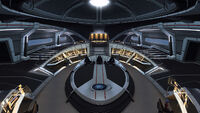
Bridge of an Odyssey -class starship, facing aft
The pinnacle of the Odyssey -class's technological achievement was the advanced quantum slipstream drive carried aboard all Odyssey -class vessels. The advanced quantum slipstream drive propelled the Odyssey -class to its fastest speed, transwarp 34.71+.
The bridge of the vessel is cavernous and features a viewscreen separate from the forward viewport , with crew stations in an oval around the chairs for the commanding and first officers . The captain's ready room is on the starboard side of the bridge, with a turbolift on the port wall and a dedicated transporter pad set into the aft wall. There is an observation deck by the forward viewport and a second, partial crew deck down a flight of stairs. ( STO mission : " The Odyssey Class ")
Service history [ ]
24th century [ ].

The USS Verity in 2385 .

The Enterprise -F over Mars .
The keel for the prototype USS Odyssey was laid in the 2380s . ( Star Trek Adventures module : Utopia Planitia Sourcebook )
The USS Verity was active by the year 2381 . Starfleet Command gave the ship to four-star Admiral Jean-Luc Picard , after reassigning him away from the USS Enterprise -E . Picard's first officer Worf was then appointed captain of the Sovereign -class cruiser . Meanwhile, Admiral Picard commanded the Verity on a mission to evacuate worlds of the Romulan Star Empire from an impending supernova . ( PIC novel : The Last Best Hope )
The mission remained active until 2385 . At the time, the Verity carried the NCC registry number NCC-97001 . ( PIC - Countdown comic : " Issue 1 ")
25th century [ ]
The prototype USS Odyssey (NX-97000) was launched in 2409 and taken on a trial cruise by one of Starfleet's leading captains . The first stage of the test involved scanning a group of satellites. During the subsequent weapons testing stage they attacked and destroyed a group of derelict Borg ships set up as targets.
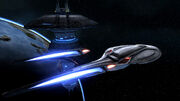
An Odyssey- class starship near Earth Spacedock .
At that moment a Klingon dreadnought arrived in Mars orbit . The captain took the ship after it and attacked the vessel, eventually inflicting severe enough damage to force them into retreat. ( STO mission : " The Odyssey Class ")
Starfleet began producing three additional variants of the class shortly afterwards. The Odyssey switched from its initial NX registry to NCC-97000. ( STO - Klingon War mission : " Welcome to Earth Spacedock ")
As the newest, most advanced class in the fleet, it was fitting that the seventh Federation flagship and the eighth iteration of the starship Enterprise be one of them. The USS Enterprise (NCC-1701-F) was launched later in 2409 under the command of Captain Va'Kel Shon . The Enterprise -F's first mission was to lead Starfleet reinforcements to Deep Space 9 to aid in the starbase 's recapture from Dominion forces under First Kar'ukan . ( STO - Lost Dominion mission : " Boldly They Rode ")
Odyssey -class vessels were also sighted under the command of the Terran Empire during their inter-universal attack on Vauthil Station . This included the ISS Enterprise -F . ( STO mission : " Mirror Invasion ")
The ISS Enterprise -F was the flagship of the Terran Empire in 2409, and under the command of the recently promoted Admiral Leeta . When Imperial Starfleet forces from the 29th century arrived in the 25th century to turn the tide against the Iconians , Leeta insisted that the Imperial flagship be the first vessel to be outfitted with the uptime technology . ( STO - New Dawn mission : " Message from Another Universe ")

Odyssey and Yorktown -class .
During the Second Battle of Earth between the Khitomer Alliance and Dominion against the Iconian Empire in 2410 , the Odyssey -class USS Yorktown (NCC-97005) was destroyed, and the Enterprise suffered extreme structural damage. Towed to Mars for service, the Starfleet Corps of Engineers rebuilt the Yorktown hulk into an upgraded, "Block II" version of the Odyssey class. The new Yorktown was recommissioned with the registry number NCC-98300 . Starfleet relaunched the Enterprise as a Yorktown -class starship. ( STO - Emergence short story : " Jayce's Navy Interstellar: Through the Valley ")
The Advanced Starship Design Bureau at the Utopia Planitia Fleet Yards developed two additional variants of the Odyssey , the Endeavour and Sojourner -class star cruisers. While the former was a more angular, military -oriented version, the Sojourner was geared towards exploration and featured a wide, circular saucer section . ( STO mission : " First Contact Day ")
In 2410, Admiral D'Vak , Worf's grandson, commanded the Odyssey -class/"Block I" USS Houston . The Houston was destroyed during a battle with the Borg Queen and her forces at Unimatrix 0047 . ( STO - Borg Advance mission : " Hive Onslaught ")
Following the Battle of Excalbia on stardate 84999.22 [9] in early 2411, which saw the prominent involvement of hero ships from the Federation's past and present, the Verity was among the command dreadnought cruisers that received a refit to legendary starship qualifications. Re-categorised as a Verity -class starship, the Verity carried the registry number NCC-97005 . ( STO website : Legacy : Legendary Command Dreadnought Cruiser )
The Khitomer Alliance partners also operated the Lexington -class dreadnought in 2411 . This Terran dreadnought cruiser was based on the Yorktown class, or "Block II". The ISS Enterprise -F was refitted to this configuration. ( STO - Terran Gambit mission : " Red Shift ")
The USS Enterprise -F and ISS Enterprise -F led a joint fleet to Pahvo in the mirror universe to stop the machinations of Wesley Crusher , Emperor of the Terran Empire . ( STO - Terran Gambit mission : " Eye of the Storm ")
26th century [ ]
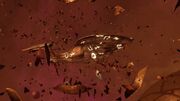
Odyssey -class wreck in 2554 .
The class remained active into the 26th century . In 2554 , at least one Odyssey -class star cruiser was wrecked during the pivotal Battle of Procyon V between the Federation, the Sphere Builders and their Temporal Liberation Front allies. This ship was part of the Federation fleet led by the USS Enterprise -J .
In one course of events, Admiral Leeta brought the ISS Enterprise -F from the 25th century to Procyon V . The Enterprise -F fought the Enterprise -J. The time travelling Odyssey -/ Yorktown -class vessel was a match for the Universe -class temporal dreadnought cruiser . A boarding action by Admiral Leeta and Imperial Starfleet was repelled by Captains Pavel Chekov and Montgomery Scott . ( STO - Future Proof mission : " Ragnarok ")
Known ships [ ]
Appendices [ ], connections [ ], appearance and references [ ].
- ↑ 1.0 1.1 STO mission : " The Odyssey Class ".
- ↑ STO - Lost Dominion mission : " Boldly They Rode ".
- ↑ STO website : Legacy : Legendary Command Dreadnought Cruiser .
- ↑ 4.0 4.1 4.2 Star Trek Adventures module : Utopia Planitia Sourcebook .
- ↑ STO - Future Proof mission : " Ragnarok ".
- ↑ 6.0 6.1 6.2 6.3 6.4 6.5 STO - Emergence short story : " Jayce's Navy Interstellar: Through the Valley ".
- ↑ STO - Klingon War mission : " Welcome to Earth Spacedock ".
- ↑ STO - Terran Gambit mission : " The Calling ".
- ↑ STO : J'Ula's Discovery .
External links [ ]
- Odyssey class article at Memory Alpha , the wiki for canon Star Trek .
- Odyssey Star Cruiser article at The Star Trek Online Wiki .
- Federation Size Chart article at The Star Trek Online Wiki .
- " Legendary Command Dreadnought Cruiser " dev blog at the ARC website .
- 1 USS Valkyrie (NCC-68816)
- 2 Ferengi Rules of Acquisition
- 3 Typhon class
Star Trek's Odyssey-Class Enterprise-F Starship Explained

This weekend, "Star Trek" fans have been hit with a spate of news from New York Comic-Con, where Paramount+ held three panels on Saturday afternoon revealing developments in the series "Discovery," "Prodigy," and "Picard" ( per Variety ). Among the much-talked-about revelations came a new trailer for the third and final season of "Picard," which is bringing back some familiar villains, such as Moriarty (Daniel Davis) and Lore (Brent Spiner) from "Star Trek: The Next Generation," and giving Worf (Michael Dorn) a new pacifist stance .
Those examining the trailer in minute detail noticed another new addition to the "Star Trek" universe: a version of the Enterprise that's not new to die-hard fans but is now making its way onto television screens: the Odyssey-class Enterprise-F starship. If you're up on your "Star Trek" universe details, you know that its predecessor, the Enterprise-E, first appeared in several installments in the 1990s, and its demise was chronicled in the "Star Trek Online" magazine, issue No. 40, in a short story called "Unexpected Honor" by Christine Thompson. This event made way for a new starship, which will be apparently making its first canon appearance. So, what's the story with the Enterprise-F, anyway?
The starship was created as a contest entry for Star Trek Online
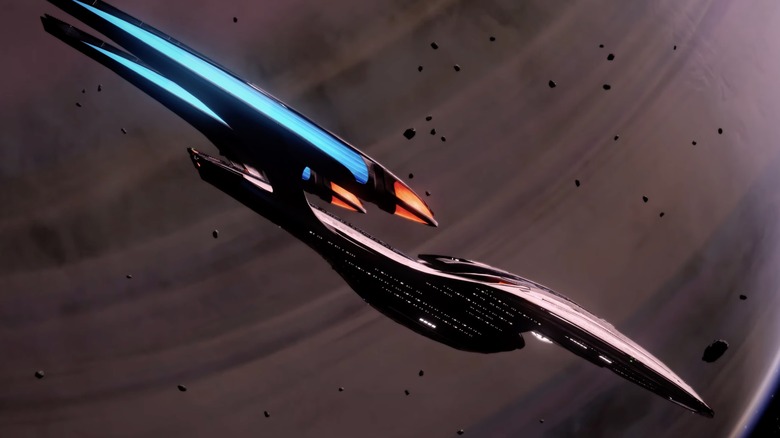
Back in 2011, Cryptic Design held a "Design the Next Enterprise" contest that was open to fans. Adam Ihle, a Florida-based sculptor and artist , won the competition with a double-necked Enterprise design that is larger and sleeker than previous iterations of the Enterprise starship, with bows at the neck and nacelles. It's designed to work well in the MMORPG's timeline, which takes place in 2409 during an era in which the Federation is at war with the Klingons, with the Romulans, the Dominion, and the Borg Collective as major players and other empires joining in additional expansions.
StarTrek.com's announcement of the win said, "Adam's sketch inspired us. It created internal discussions about the evolution of the Starfleet Cruiser and how this ship represented a new approach to design that would lead us into the future. The silhouette remains familiar and recognizable, yet the ship offers an evolution in design that adds both beauty and function worthy of the name Enterprise ... We're thrilled to have brought this design to life and feel that the final render elegantly captures in high detail the spirit and flow of Adam's original."
The ship was then revealed in a "Star Trek Online" feature episode from 2012 ( via TrekNews.com ). Given that the ship's design is more than a decade old, it might have been a surprise to Ihle that it has appeared in canon, but he is clearly reveling in the attention the "Picard" announcement has provided. "Don't like the Enterprise F? Well, you can hate it all you want and I'll be over here enjoying being a part of canon Star Trek history," he tweeted yesterday .
The ship's graphics were also rebuilt in 2021 by Thomas Marrone, a Cryptic Studios artist.
The Enterprise F has some impressive specs
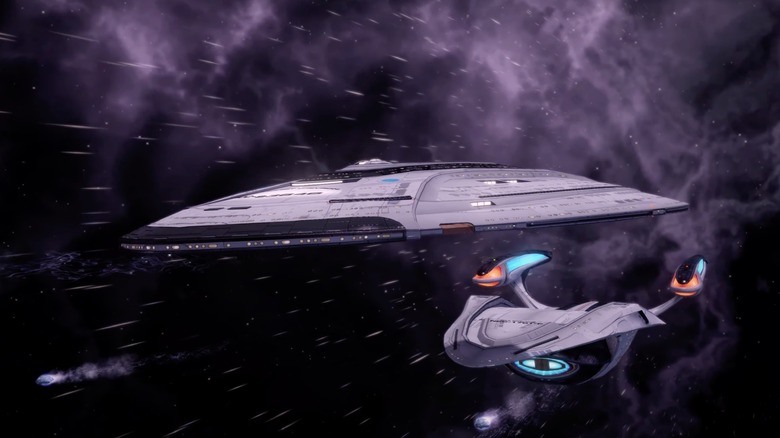
According to a fan who analyzed the Enterprise-F's design, you can see both elements of the Enterprise-D and -E in the ship's profile; it has an overall shape and elonged front disc shape borrowed from the Enterprise-E, with a hull design, impulse exhaust ports, main shuttle bay, and a sensor array strip on the ship's saucer section that more closely resembles the Enterprise-D. YouTuber Junkball also points out that the main body of the saucer section has an hourglass section that resembles that of the Enterprise-J, a ship introduced from a possible future in the third season of "Star Trek: Enterprise."
According to Giant Freakin Robot , the size of the Enterprise-F is 1,061.1 meters in length and 371 meters in width, which is much larger than the 685-meter-long Enterprise-E. It holds a standard crew of 1,600 with a crew cap of 2,500 and can travel at a maximum warp speed of 9.99. It is equipped with transwarp and slipstream drives. Giant Bomb further reveals that — at least in-game — the ship has four fore and four aft weapons, and five officer stations.
However, although the Odyssey-class ship is being made canon, that doesn't mean every detail of it — including the crew's identities — will be. Hopefully, more will be revealed once "Picard" returns to the Paramount+ streaming service with Season 3 on February 16, 2023.
Odyssey class
Odyssey -class
The Odyssey -class starship was a type of dreadnought cruiser that officially entered Starfleet service in 2405 at the height of the Third Federation-Klingon War although due to the use of Krenim Technology in 2410 which created an Alternate Timeline in which they were fully launched much earlier in 2386 in responce to the Destruction of the Utopia Planitia Fleet Yards and Loss of the Enterprise-E.
- 1.1 Revised Timeline
- 2.1 Physical arrangement
- 2.2 Propulsion systems
- 2.3 Tactical systems
- 2.4.1 Hazard Team
- 2.5 Medical systems
- 2.6 Science systems
- 2.7.1 Operations
- 2.7.2 Science
- 2.7.3 Tactical
- 2.7.4 Dreadnought
- 3.1.1 Battle Bridge
- 3.2 Interior
- 3.3 Living Spaces
- 3.4 Crew Recreational Areas
- 4.1.1 Ranks
- 4.1.2 Uniforms
- 4.1.3 Division Colours
- 4.1.4 Equipment
- 5.1 Transporter rooms
- 5.2.1 Embarked craft
- 6 Ships commissioned
- 7 Commanding Officers
- 9 External Links
History [ ]
First conceptualized in 2381, the Odyssey -class was conceptually an extension of the Constitution -class design lineage of a large multirole cruiser . However, due to its size and power the Odyssey was classified as a dreadnought . In peacetime, it served the role of an explorer on long-term deep space missions. In wartime, the class was meant to act as the hard-hitting core of large starship formations, though it was fully capable of solo operations.
The initial design received final approval in 2406 and the first four ships of the class began construction that year. The USS Endurance would be constructed at the San Francisco Fleet Yards , while the USS Odyssey , USS Houston , and USS Valentine were laid down at Utopia Planitia Fleet Yards . As construction progressed engineers at Utopia Planitia developed three variants that were applied to frames being constructed there.
In 2408 , the USS Enterprise -E was decommissioned due to battle damage sustained under classified circumstances. The incomplete USS Endurance was re-designated the USS Enterprise -F . Captain Data of the Enterprise -E was offered command, but declined.
The science variant Enterprise -F was first out of spacedock in mid- 2409 , dispatched to Deep Space 9 before her official launch and with much of her interior still incomplete, as the flagship of Vice Admiral Manuele Atoa with Captain Va'Kel Shon as flag captain , leading half of Home Fleet to reinforce against 2,800 time-displaced Dominion warships that had appeared through the Bajoran wormhole . The action was successful, and Starfleet Command ordered a second production run of twenty ships. The Odyssey , Houston , and Valentine would be completed and launched in mid-August, with the Enterprise joining the launch ceremony for her official debut.
The first Odyssey -class would be lost in battle in December of that year when the Houston engaged a pair of command ships of Borg Unimatrix 0047 . Admiral D'Vak became separated from his screening vessels, and the ship was struck amidships by a plasma lance and vanished in a fireball seconds later.
[Update TBA]
First conceptualized in 2381, the Odyssey -class or Verity- class as it was called at the time was conceptually an extension of the Constitution -class design lineage of a large multirole cruiser . However, due to its size and power the Odyssey was classified as a dreadnought . In peacetime, it served the role of an explorer on long-term deep space missions. In wartime, the class was meant to act as the hard-hitting core of large starship formations, though it was fully capable of solo operations.
The first 2 ships of the Verity class bagan construction in 2381 however production on the USS Odyssey was haulted soon after when it was discovered that the main star Hobus System had suddenly begun turning into a supernova at an accelerated rate as well as Mysteriously transfering much of its Energy into Subspace thus drastically increasing its destructive range.
With the imminent danger to multiple Romulan Worlds, several federation planets along the border and Romulus iself all resources were shiped to complete the USS Verity and assemble an armada of Warp Capable Tugs to evacuate any thretened planets. In 2387 the Hobus Supernova went Supernova despite Starfleet assistance. Spock's sacrifice having presuably being consumed by a Black Hole created using Red Matter to collapse the Supernova helped prevent further loss of life but was not soon enough to prevent the destruction of Romulus.
Bruce Maddox from the Daystrom Institute had sucsessfully revived the lost Commander Data using the body of his brother's Lore and B4, athough with some initial resistance Jean-Luc Picard had convinced Starfleet Command to give Data Captaincy of the USS Enterprise-E. In 2399 the Enterprise-E was destroyed by the Undine.
Later in 2405 the Klingon Empire would declare war on the Gorn Hegemony believing that they had been compremised by Undine Infiltration (Which would eventually be proven correct), causing a break down of diplomacy between the Empire and the Federation thus all out war between the two most dominant powers in the region was inevitable.
In 2409 the Borg began their invasion of Federation and Romulan Space setting up Transwarp Corridors in the Azure Nebula, although in many numbers starfleet had advanced their technology rapidly in preparation for this and for the most part the borg were temporarily contained. Following A Time displaced dominion take over of Deep space 9, The USS Enterprise NCC-1701-F would be launched with Andorian Captain Va'kel Shon former CO of the USS Belfast in command. Later that year the Iconian War began, lasting into late 2410 in which the Alliance of the Federation, Klingon Empire and the newly formed Romulan Republic were losing, in a desperate attempt to postpone the Iconian War the Alliance used Krenim Technology to altertime however this would have far reaching consequences.
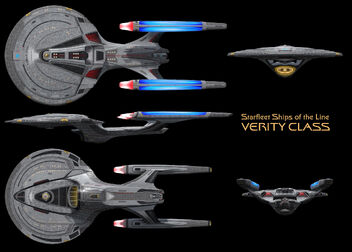
Verity Class Cruiser (Enethrin)
Revised Timeline [ ]
USS Verity (NCC-79000) would be launched in early 2382 under the command in the recently promoted Admiral Jean-Luc Picard and his aid Lieutenant Commander Raffi Musiker of Romulan Affairs. In 2385 Utopia Planitia was destroyed by Hijacked Synthetics destroying much of the romulan Evacuation Fleet and causing the Federation to Pull the plug on the Evacuations and Admiral Picard Resigned in protest. In this timeline Data would continue to be deceased until 2401.
In 2385 the Enterprise-E was lost while under command of Captain Worf and one year later Starfleet would revive their Super Capital Designs using updated Technology relaunching the USS Odyssey as well as the New USS Enterprise-F under the command of Various decorated Officers. By 2401 thirteen Odyssey Classes had been constructed with 3 being moderately damaged during that year's Frontier Day Celebrations when they were temporally commandeered along with the majority of the fleet by the last remnants of the Borg Collective with assistance of Rogue Changelings. Admiral Picard would use the non-networked USS Enterprise-D to destroy the theoretically last Borg Queen and the Borg in this timeline were rendered extinct.
In 2402 the Constitution III Class USS Titan-A was renamed the Enterprise-G now under command of Captain Seven. In 2405 the Odyssey class became a crucial component of Star fleet Battle Groups during The 3rd Klingon-Federation War as well as in the later Iconian War. During the course of these two conflicts the ranks of the Odyssey class had been decimated with only 1/3rd surviving and all those requiring extensive Repairs. In 2411 following the 3rd Battle of Earth also known as the Battle of Midnight, Odyssey classes were refitted into 3 Sub-classes thus revitalising the new Super Capital Designs.
The Odyssey Class and its Sub-Classes would remain in service for an extremely long time although they would eventually begin showing their age, by the early to mid 26th century most had been retired. Several did participate in the Battle of Procyon V against the Sphere Builders along side the other long lived classes such as the Hydra and Equinox as well as Starfleet's new designs incorporating early iterations of temporal technology.
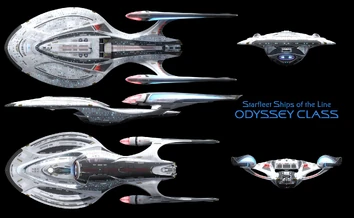
Odyssey Class Star Cruiser (Enethrin)
Technical information [ ]
Physical arrangement [ ].

Saucer separation in progress.
The Odyssey- class used the same basic saucer-hull-nacelle arrangement common to most Starfleet capital ships. Like the Galaxy -class of nearly sixty years before, it was composed of two hull sections: an egg-shaped, domed primary hull, and a detachable secondary hull housing the main engines and warp drive. They could be reversibly separated, affording the stardrive section improved agility.
The stardrive section was reminiscent of an enlarged Sovereign -class, with the saucer fitted to a triangular dock that mated to the engineering hull by two slender necks. The warp nacelles were long, wide-spread, and mounted to the engineering hull by aft-swept pylons.
At the Bow of each Odyssey-class was a fixed area of Reinforced Diburnium Plating. This feature was added due to the massive damage sustained by the Sovereign-class USS Enterprise-E in 2379 during the Battle of the Bassen Rift when she Rammed head first into the Reman Warbird Scimitar in a last effort to disable the colossal ship. Diburnium is a Super Heavy Metallic Element with Phaser Resistance Qualities and is occasionally combined with various other elements including Osmium to create extremely durable alloys.
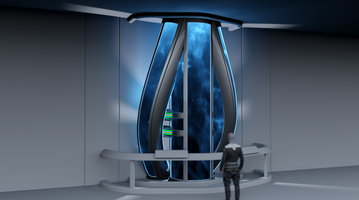
Odyssey Class Quantum Slipstream Core
Propulsion systems [ ]
In addition to the Impulse Engines and Matter/Anti-Matter Warp Drive common to all Starfleet vessels, the Odyssey Class included a Standard Starfleet Quantum Slipstream Drive. The dual-neck design afforded the vessel improved stability under slipstream, enabling it to sustain the field twice as long as any other vessel. This gave it the highest effective faster-than light speed equivalent to transwarp factor 34.71 matching the Slipstream Capabilities of the later Khitomer Class Battlecruiser with the latter also having a more efficient Warp Drive due to the use of Klingon Warp Coils.
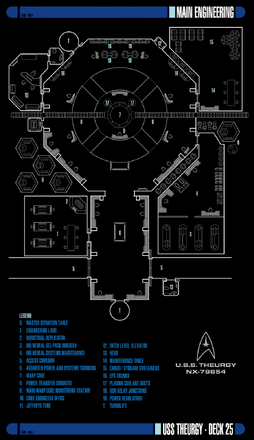
Odyssey Class Main Engineering Layout (Theurgy)
Sub-light Manoeuvrability was provided by 2x Charon Yards Hyper Impulse Engines located on the Primary Hull, 10x Zhiv/Ren SR83 Impulse Thrusters integrated into the Nacelle Pylons as well as 8 Sublight Thruster Modules with 44 individual vector thrust nozzles making the Odyssey class Extremely Nimble for its colossal size. 4 Gimbaled Warp Field Governors were intigrated into the Odyssey class improving Warp Stability.
Monitoring, Maintenance, Upkeep and Upgrades of the Propulsion Systems were coordinated by a Main Engineering constructed around a class 9 later updated to Class 10 warp drive with a tricyclic input manifold. The core provided a maximum output of over four thousand teradynes per second. The warp drive was designed to operate for up to three years before refuelling. The reaction chamber was equipped with a compositor, which allowed recrystallization of dilithium based on shared Xehean designs. The warp drive allotted these ships a top sustainable cruise velocity of warp factor 9.5 and a Maximum of Warp 9.995 and later improved to Warp 9.999 by 2405.
The main engineering room featured three levels between decks 23 and 25. In front of the warp core was a large monitoring area on the lower engineering level. Also located on this level was the chief engineer's office and an open work area for special projects or situational analysis. The main impulse engines on an Odyssey-class starship were located on the aft primary hull. Each of the pylons leading to the warp nacelles held auxiliary impulse engines. Odyssey-class starships were also equipped with auxiliary impulse reactors.
In the event of a warp core breach, the Odyssey-class starship could eject the warp core. This procedure required the authorisation code of the chief engineer or a member of the senior staff. The core was ejected through the ejection port on the hull. Magnetic rails inside the channel accelerated the core once disengaged from the vessel and flung it away from the ship. Under normal circumstances, the vessel then moved away from the core as fast as possible under impulse power. Should the core not go critical, the vessel could recover it with tractor beams and reintegrate it with careful manipulation.
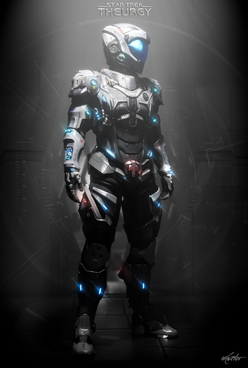
Mark-II EVA Suit (Theurgy)
Tactical systems [ ]
The Odyssey -class was heavily armed and incredibly resilient under enemy fire. With the saucer docked it mounted enough phaser arrays to be able to hit any point in surrounding space with at least four or more beams simultaneously it housed 18x Mk XII Phaser Arrays, 6x Variable Payload Warhead Launchers, 2x Phaser Cannon Turret Mounts located on the dorsal and ventral secondary hull, 2x Heavy Phaser Cannon Emitters on the fore of the Primary Hull. The Odyssey -class carried both Photon and quantum torpedoes as standard ordnance. For bombardment of hardened targets such as enemy starbases it also carried a complement of tricobalt devices. All Phasers made use of integrated Annular Confinement Beam-jacketing devices allowing them to be fired at FTL Speeds and penatrate Warp Fields.
The Odyssey classes used a GE-219 Deflector Shield Grid to projected a Multi-Quantum Spatial Unimatrix Shield System with multi-spectrum, covariant, and metaphasic properties. Nexus Defense Screens protected the crew from the effects of the Nexus and similar phenomena, were also integrated into the shield systems. Odyssey class shields were regenerative using technology tested on the Prometheus Class.
The Odyssey's active protection system (APS) consisted of three Type VII phasers and complex cyber-electromagnetic countermeasure (CEMCM) systems. The latter allowed each starship to create powerful fields that provided some protection against sensor scans, target locks, digital assaults, and other CEM attacks. The CEMCM could also be employed offensively, for sensor disruption and signal scrambling. One of the phaser turrets was only employed during saucer separation, as it was located on the dorsal side of the forward secondary hull.
The boarding prevention systems (BPS) of the cruisers included passive internal sensor systems, to detect and locate unknown entities aboard, and inhibitors attuned to only Federation transporter signals. The Odyssey Class hull is made of Duranium-Tritanium Double Layered Plating, Tritanium-Rodinium Composite Armour as well as Type-3 Ablative Hull Armour. Intended as a last resort, the Odyssey -class was equipped with an Auto Self-Destruct System. It could only be activated by special command authorization and would destroy all key systems and facilities to prevent their recovery by any opposing forces.
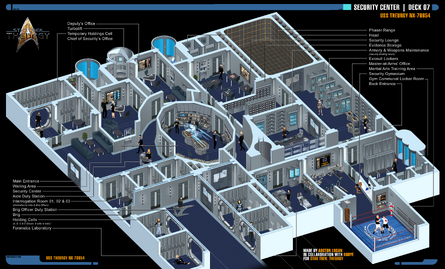
Odyssey Class Security Center (Theurgy Wiki)
Security Systems [ ]
Odyssey classes contained multiple Security Checkpoints, Brig's and Weapons lockers coordinated by a dedicated Security Centre in case of a malevolent boarding against the crew. During a Security emergency all defence operations could be organised from this area, as such it was one of the few places that only senior and command officers could enter without going through a security checkpoint. The Security Center has its own Power source, Holding Cells, Interrogation Rooms, Forensics Lab, Weapons Lockers and Training Areas, it is also Restricted to Civilians without authorisation from a Senior Officer. Throughout the ship Security details would make rounds and security checks in key locations at regular intervals.
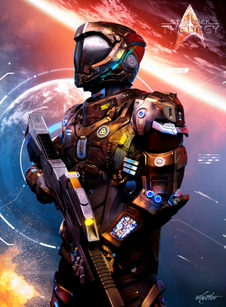
Hazard Team Tactical EVA Suit (Theurgy)
Hazard Team [ ]
A Hazard Team was the field unit of the Military Assault Command Operations Division of Starfleet Security Command. Originating in the late 24th century, the first use of the term was for units created by Lieutenant Commander Tuvok aboard USS Voyager during its 7-year unplanned journey through the Delta Quadrant. Tuvok's program established an elite force of security officers, medics, and pilots that were utilized to take control of extreme situations and high-risk away missions. Upon Voyager 's return to United Federation of Planets territory, the program continued aboard the USS Enterprise -E. After the continued success of these Hazard Teams, the Chief of Starfleet Security decided to fold the program into the reformed Military Assault Command Operations. Hazard Teams then became the special operations field units of Starfleet Security from 2381 onward.
Each Hazard Team consisted of four to five members with a team leader, medic, weapons specialist, pilot, and engineer. Roles would often overlap and additional experts would be assigned to a specific team on an as-needed basis. For larger operations, personnel would be grouped into squads of three to four teams. All Starfeet's Command Vessels had their own dedicated Hazard teams including the Odyssey Class. During extended periods of conflict squads of Marines or MACOs could also be assigned to front line Starships and Facilities.
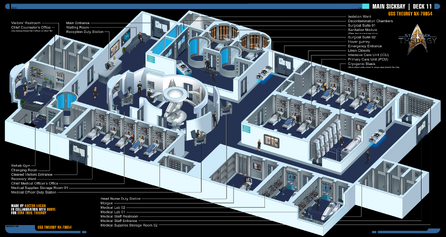
Main Sickbay (Theurgy Wiki)
Medical systems [ ]
The Odyssey-class contains 1 Main-Sickbay ward in the Primary Hull located on Deck 12 as well as 2 smaller Battle sickbay's in the Secondary Hull, and would be the template for the Facilities on the later Theurgy Class. As such they all contained the necessary facilities to treat a not insignificant portion of the ship's compliment. During an emergency, Triage could be handled by lower ranked personnel with adequate medical training using Medkits housed in every corridor on the ship and multiple in dedicated safe shelters. Sickbay also included Counselling Offices, Morgues for the storage and autopsies of any deceased and Stasis Units for fatally injured personnel when resources are in high demand. If a Contagion made it onto the ship in some way the ships sections could be sealed off on the authorisation of a ranking officer or automatically as well as decontamination rooms and Medical Sterilisation Sonic Showers to clear foreign agents. Sickbay was outfitted with holo-emitters and the newest generations of Emergency Medical Holograms as well as a dedicated Long-term Medical Hologram.
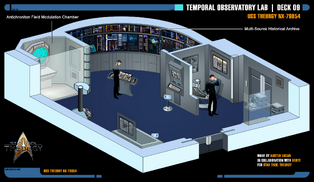
Odyssey Temporal Observatory Lab (Theurgy Wiki)
Science systems [ ]
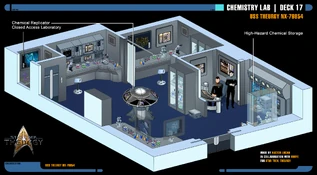
Odyssey Chemistry Lab (Theurgy)
The Odyssey Class included 4x DYN-75 Multi-Band Linear Sensor Suites, 4x Omniwave Passive Sensor Matrices and 1x J-DOME Planitary Sensor Array giving it some of the best scientific capabilities although it would be superseded in scientific capabilities by the Sutherland and Grissom Class Science Vessels.
The Navigational Deflector is a Molybdenum & Duranium Mesh design similar to that on the Guardian Class Powered by Six Graviton Polarity Generators an Output of 450 Gigawatts and Field Strength of 750 Millicochranes. Imbeded in the Bow of the Saucer section's Reinforced Diburnium Alloy Brace are 4 Heavy Probe launchers alowing for the rapid dispencing of sensor & mapping probes, satalites, subspace transceivers and other equipment.
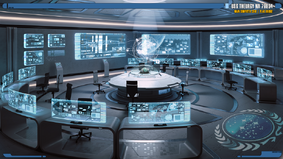
Odyssey Class main Computer Core (Theurgy)
The Odyssey Class includes Multiple Tractor Emitters powered by 4-15 Gigawatt Multi-phase Graviton Polarity Sources each with a Field Strength of 490 Millicochranes featuring a range of 150 Million tons at 2 Kilometers to 1 ton at 30.000 Kilometers. The Odyssey classes Computer Systems are comprised of two Type 2 Integrated Positronic Processing Bioneural Isolinear Cores, LCARS 7+ Computer Interfaces, A storage capacity of 1953 TeraQuads and a processing speed of ,014,500 ExaFLOPS. The Standard Communications systems allowing 2,500,000 Kilometers to 18 Light-years for Real-Time Transmission, a Transmission capacity of 17.2 kiloquads per second and speed of approx. Warp 9.9997.
During construction Technology used in the MIDAS Array was implemented allowing the Odyssey Classes to communicate across Quadrants within minutes similar to the later Pathfinder Class. The ships Astrometric and Stellar Chartography Lab was located between Decks 5 and 7, Cetaean Ops was located on Decks 5-11 and was connected to the Arboretum. A Hydroponics Bay for Flora studies and growing produce was also included.
Variants [ ]
In early 2411 after the Second Battle of Earth (also known as the Battle of Midnight), Starfleet engineers and the Advanced Starship Design Bureau looked to expand upon the Odyssey class variants using the derelict hulks of Odyssey Classes destroyed in the Iconian War. The original class and variants were dubbed Block I, with this new Sojourner, Endeavor and Yorktowns, being labeled Block II. In 2409 the Terran Empire had acquired a Block I Odyssey class model along with the Technical Schematics for a Block II Yorktown by late 2411, Later that year they were able to redesign their own Version creating the Lexington Class Dreadnought Cruiser. All Block II and Block III odysseys would include a Quantum Slipstream Projector.
Operations [ ]
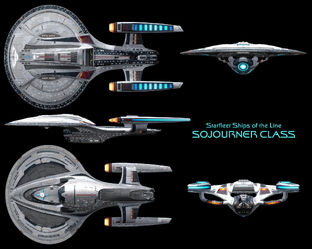
Sojourner Class Operations Cruiser (Enethrin)
The Sojourner Operations Cruiser variant was intended to enhance extended operation during multipurpose missions. The EPS systems were balanced to provide equal power generation across all primary systems. Redundant power generation systems and improved warp field design also integrated a more efficient saucer separation allowing most of the crew and any civilians aboard to rapidly be evacuated in an emergency. The more circular Saucer section of the Sojourner class housed a ring of enclosed Warp coils powered by a miniaturised warp core thus granting the Primary hull independent warp capability based on the Ross Class.
Block II Sojourner Classes were outfitted with the latest design of Industrial and Vehicle Replicators allowing them to manufacture complex components and even whole auxiliary craft within minutes (This system was tested on the Protostar Class in the early 2380s and further refined in the Lancelot Class). Sojourner Classes could quickly transport prefabricated equipment onto planetary surfaces or the surrounding space like the experimental automated Texas Class.
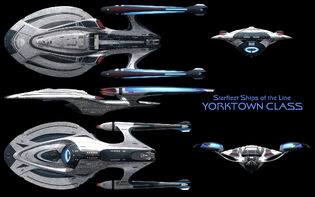
Yorktown Science Cruiser (Enethrin)
Science [ ]
The primary mission of Starfleet was scientific exploration. The Yorktown Science Cruiser variant met these goals with unmatched sensor enhancements, unseen in previous cruiser designs. Along with enhanced shield power, Workbee Cargo Management Units were typically assigned to this class in order to support ship operations on extended scientific endeavours. Odyssey Classes include various Intelligence Suites, Temporal Observatories, Stellar Cartography and labs dedicated to multiple sciences including: Archaeology, Geology, Hydroponics, Planetology, Physics, Chemistry, Xenobiology & Cybernetics, various Library and Research Rooms as well as a dedicated Holographic Research Lab. The Block II Yorktown would also have the most extensive and advanced medical facilities of the Odyssey Class Variants with 2 Main Sickbays and 2 Battle Sickbays. Newer and more powerful Impulse Engines were added, the Pylons were reinforced and flaring was added to the Nacelle ends improving Warp stability.
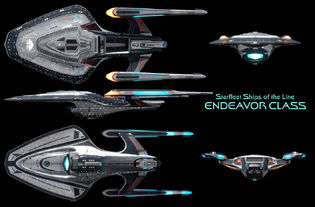
Endeavour Class Tactical Cruiser (Enethrin)
Tactical [ ]
In this extended period of conflict, the Starfleet Corps of Engineers were tasked with developing a cruiser with additional firepower. The Endeavour Tactical Cruiser variant was a unique development that emerged from this goal. While the EPS systems were tuned to provide superior power to its additional weapon hard points. The Endeavour's hull and shields would also be enhanced increasing survivability. Its hangers would be redesigned allowing more Warp Fighter craft to be stored, maintained and launched. The Class was outfitted with the Updated Eagle Class Raider which replaced the old Aquarius Escort Model. The Odyssey's Reinforced Diburnium Plating was enlarged now encompassing the Saucer's rim and reinforcing other areas of its structure.
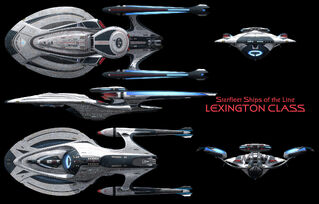
Lexington Class Dreadnought Cruiser (Enethrin)
Dreadnought [ ]
The Lexington Class Dreadnought in the form of the ISS Enterprise-F was the Flagship of Admiral Leeta one of the most ruthless members of the Mirror Universe's Imperial Starfleet. This Class has the basic frame of a Yorktown Class but also included an update Eagle Class Raider, an Agony Spinal Lance Phaser fixed to the underside of the Primary Hull.
A Mission Pod is placed above the Secondary Hull which could be switched out for a Multi Target Artillery Platform containing additional Phaser emitters and Torpedo Tubes, a Through Deck Hanger for additional Warp Fighters, a Long-range Sensor Array for Intelligence Gathering Missions or a 3rd Nacelles providing increased warp stability and speed similar to the earlier Galaxy Dreadnought Model.
Along with the Eagle Class raider the designs for this class were acquired by their Federation counter parts and 6 Block II Yorktown Classes were retrofitted to the specifications.
Interior design [ ]
Main bridge [ ].
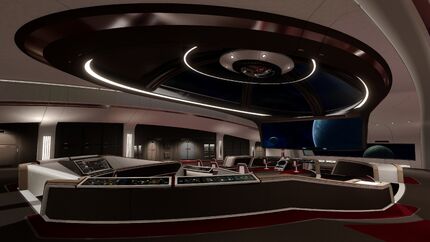
Odyssey Class Bridge 2411
The main bridge of the Odyssey -class spread over parts of Decks 1 and 2 and had a vaulted ceiling staring into space. The Odyssey-class bridge was extremely large aiding in its primary role as an Exploration and Diplomatic starship. This space could also be used as a makeshift control room for a Sector commander if there was no preset Starbase facilities.
It containes chairs for the commanding officer and two staff in the centre facing a large viewscreen. The Navigation & Flight Ops (CONN) and Operations Management stations sat to either side of the viewscreen. Behind the command area were four consoles dedicated to Mission Ops, Engineering, Science as well as Communications & Environmental Control (These Consoles departments could be quickly switched out on the fly). Overlooking these stations and the command area were the stations for Tactical, Security and Flight Deck Ops. All Consoles aboard used the latest LCARS Design and could even be modified to Non-Starfleet or manually changed and redesigned by their users. At the rear of the cavernous bridge was a seven-pad transporter with doors leading to a Mission Operations and Intelligence Suite usually off-limits to unauthorised personnel. The control panels are touch pad style but could be switched to holographic in later iterations.
At the centre of the bridge, just in front of the command chairs and behind the CONN and OPS consoles is an extendable Tactical Holographic Situation Dias, which provides the Command Staff with quick access to information in tense situations. The Dias can also act as an impromptu meeting and situation area for the senior and bridge officers. The Command chairs have panels integrated into the armrests allowing for the display if vital information at a glance and access to main computer for the retrieval of information, utilising command codes and recording logs. Also included each command chair and the CONN Station are manual steering control joysticks providing fine manual piloting control in situations where the normal helm controls were not precise enough, were inoperable, or if preferred by the pilot over conventional push button or touch interfaces.
Two bridge turbolifts were located on the port side, with the entrance to the ready room on the starboard. On the walls surrounding the bridge were storage lockers containing equipment, on duty food replicators and auxiliary computer access terminals, Other exits lead to the Head and the rest of Deck 1 connected to the bridge escape pods, Environmental Suits adjacent to a rear Airlock and a turbolift to the Battle Bridge.
An observation area was between the viewscreen and the forward view-port. The Sub-deck of an Odyssey bridge served as the executive Conference/Observation room containing a conference table and multiple Holographic Displays and Consoles. The observation lounge was used as a meeting place for the ship's senior staff as well as special events and gatherings. Most went to the observation lounge simply for the view.
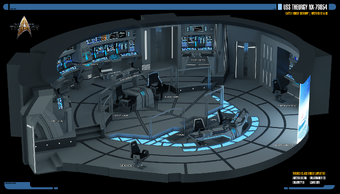
Odyssey Class Battle Bridge (Theurgy)
Battle Bridge [ ]
A Secondary/Battle bridge was housed within the Forward Secondary Hull on Deck 13 and served as a secondary central command facility in the event that the main bridge was unusable or inaccessible. It also served as the primary command facility of the star-drive section during saucer separation scenarios. It was Smaller and more compact than the Main Bridge but still contained all the necessary stations to command the ship effectively. (If either the Main and Battle Bridges were inoperative control was transferred to Main Engineering).
The Battle Bridge was the same as the later Theurgy Class Vector 2 and 3 Bridges and shared a passing resemblance to the Intrepid Class Bridge but with a different style and updated consoles forgoing the holographic consoles used on the main bridge for more traditional integrated panels although several stations were switched. The Tactical Station was split into separate Tactical and Security Stations, the later replacing the Ops console which is merged alongside the Helm at the fore of the bridge while the Science and Engineering Stations swap places. The CO and XO command Chairs also switch places with the confined View-screen being replaced by a larger (and arguably more cinematic) Holo-Projected screen used to simulate visuals overlay-ed on a reinforced bulkhead similar to the original Sovereign Class View Screen.
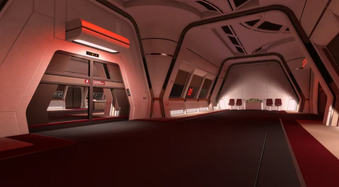
Odyssey Class Interior Design (2411)
Interior [ ]
The Interior Corridors of the Odyssey Classes have a primary white colour palate with red and black accents. Holding an M-class environmental standard Odyssey classes could also alter sections of corridors, entire decks or just the area around one person to simulate multiple environments. Holo Emitters were installed throughout the ship allowing Emergency Medical, Security and Engineering Holograms to be activated on any deck. Force Field Emitters were integrated in every corridor in the event of a hull breach, contain hazardous materials and suppress fires, or allowing anyone with authorisation to restrict borders movements although they could be deactivated with sufficient firepower or technical expertise.
Each Odyssey class had their own dedicated photonic core which stored the programs for five Emergency Medical Holograms, five Emergency Engineering Holograms, twelve Emergency Security Holograms, and a single Emergency Command Hologram.

The Emergency Holographic Crew Replacement System (EHCRS) was an experimental holographic program based on the Emergency Command Hologram from the USS Voyager, This system used the holo emitters on every deck of the starship being capable of immediately replacing a living Crew Member at a control station if they leave, are evacuated or incapacitated thus allowing the ship to function with no crew aboard in an emergency for an almost indefinite amount of time.
With the Partial adaptation of Mobile Holoemitters based on a detailed analysis of the Original Device Procured by the USS Voyager in 2373, these Holographic Crewmen can alter their programming code and leave the confines of areas with Holoemmitters for a limited amount of time. Although Starfleet Command still maintains that Self-Aware Holograms require authorisation to be created.
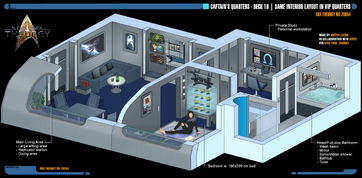
Captain and VIP Quarters (Theurgy)
Living Spaces [ ]
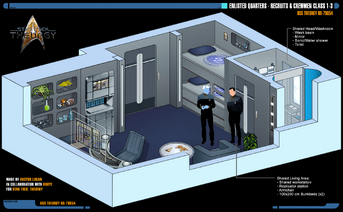
Elisted Quarters (Theurgy)
Most crew quarters on the Odyssey-class were located in the ship's saucer section, in order to provide safety for civilian and non-essential personnel during Saucer Separation. However, the engineering hull also contained crew quarters, generally containing operations personnel.
- Captain's Quarters & VIP Quarters
- Departmental Heads' Quarters
- Senior Officers' Quarters
- Junior Officers' Quarters
- Shared NCO Quarters
- Shared Enlisted Quarters
Crew Recreational Areas [ ]
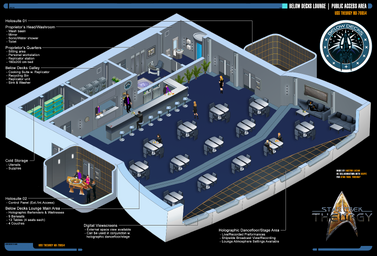
Odyssey Class Below Deck Lounge (Theurgy Wiki)
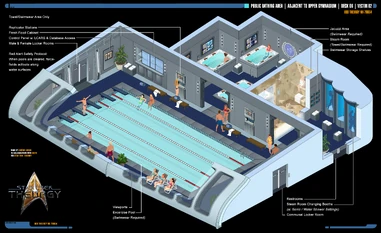
Odyssey Class Public Baths (Theurgy)
Odyssey Classes include Gym's, Bars, Holodecks, Rec Rooms, Baths, Lounges, Cetacean Operations and Arboretums for crew comfort and support.
- The Gymnasium included Sparring Rings, Workout Gear, Yoga Mats and Gravity Weights and Punching Bags which can be altered to simulate the relative form and durability of almost any species on record including Human, Andorian and Klingon allowing those using them to customise their workouts. Interactive sparring holograms could also be created.
- Recreation areas include eating and gaming areas as well as performing areas equipped with holographic projectors for entertainment.
- Rec Rooms can be customised by their occupants allowing competitive gaming (such as Phaser Tag, Parrises squares, Hover Boarding, Mok'bara Training, Velocity, Tsunkatse and Anbo-jyutsu) as well as lectures, symposiums and chapels.
- Adjacent to the gymnasium was a Public Bath complex with both Sonic and water showers, a Steamroom and Kacuzzi connected to an Exercise Pool with windows to space (windows can be dimmed for more privacy).
- Holodecks are standard for the time allowing the crew to create any environment imaginable (Although capable, the creation of Sentient or Self-aware Programs which can alter their own algorithms and the dispensing Reverse Engineered Mobile Holo Emitters requires the authorisation of the Ship's captain). Holodecks are located on Decks 5-6.
- Odyssey classes include approximately 338 Type A Mark IX and 8 Type C Mark XII Autonomous Survival and Recovery Vehicles (ASRV). Each of the Type A evacuation pods sit in its own ejection berth.
- The Officers Lounge found on forward Decks 5 & 6 overlooking Cetacean Ops and the Arboretum. The public Library and Research Room contains networked computers as well as storage and replicators for traditional Hard Copy Books.
Officers, Uniforms and Equipment [ ]
The most Important positions aboard an Odyssey Class starship are those filled by Command Officers, Deportment Heads and Senior Officers. Depending on the duties and size of any given Starfleet ship most Officers and Enlisted personnel are assigned to one of these departments.
- Command : Commanding Officer, Executive Officer, Captain's Yeoman, Mission Ops Asstant
- Tactical : Chief Tactical Officer, Asst. Chief Tactical Officer
- Flight Operations : Chief CONN Officer, Asst. Chief CONN Officer, Chief Support Craft Pilot, Support Craft Pilot
- Diplomacy (If Assigned) : Chief Diplomatic Officer, Asst. Chief Diplomatic Officer, Diplomatic Attaché
- Intelligence (If Assigned) : Chief Intelligence Officer, Deputy Chief Intelligence Officer, Senior Intelligence Analyst, Intelligence Operative
- Security : Chief Security Officer, Deputy Chief Security Officer, Investigation Officer, Master-at-Arms, Combat Medic
- Tactical Flight Ops (If Assigned) : Group Commander, Wing Commander, Squadron Commanding Officer, Flight Leader
- Medical : Chief Medical Officer, Asst. Chief Medical Officer, Head Nurse, Chief of Surgery
- Counseling : Chief Counselor, Asst. Chief Counselor, Psychiatrist & Morale Officer
- Engineering : Chief Engineer, Asst. Chief Engineer, Systems & Maintenance Engineer, Holo-Systems Engineer
- Operations Management : Chief Operations Officer, Asst. Chief Operations Officer, Transporter Officer, Chief of the Deck, Head of Fighter Weapons & Ordnance
- Science : Chief Science, Officer Asst. Chief Science Officer, Science Officer (Warp Theory), Temporal Affairs Officer, Science Officer (Stellar Cartography), Science Officer (Botany), Science Officer (Xenoanthropology), Science Officer (Xenobiology), Science Officer (Chemistry), Lab Technician (High Energy Physics), Bioengineering Specialist
- Civilian : Liaison Officer, Specialist, Advisor, Observer, Teachers, Host, Trainee, Cadet
Ranks, Uniforms, Division Colours, Accessories & Equipment [ ]
- Flag Officers: Fleet Admiral, Admiral, Vice Admiral, Command Master Chief Petty Officer, Rear Admiral, Commodore
- Line Officers: Fleet Captain, Captain, Commander, Lieutenant Commander, Lieutenant, Lieutenant Junior Grade, Ensign
- Provisional Officers: Provisional Captain, Provisional Commander, Provisional Lieutenant Commander, Provisional Lieutenant, Provisional Lieutenant Junior Grade, Provisional Ensign
- Warrant Officers: Chief Warrant Officer 1st Class, Chief Warrant Officer 2nd Class, Chief Warrant Officer 3rd Class, Warrant Officer
- Enlisted & NCOs: Master Chief Petty Officer, Senior Chief Petty Officer, Chief Petty Officer, Petty Officer 1st Class, Petty Officer 2nd Class, Petty Officer 3rd Class, Crewman 1st Class, Crewman 2nd Class, Crewman 3rd Class, Crewman Recruit
- Cadets: Cadet 4th Year, Cadet 3rd Year, Cadet 2nd Year, Cadet 1st Year
Uniforms [ ]
Starfleet uniforms were uniforms worn by individuals serving in the Federation Starfleet, originally a United Earth organisation. These uniforms facilitated the wearers' needs as both scientists and researchers, as well as Starfleet's military role. Wearers were expected to abide by the Starfleet dress code, though special exceptions were sometimes made for certain aspects of an individual's cultural heritage, such as Klingon baldrics, Ferengi headdress and Bajoran earrings. Officers could also wear Gloves, Head & Hair Bands, Hijabs as well as V.I.S.O.Rs, containment Suits and Exo-frames or any other devise required by the individual.
Crews could also wear embroidered baseball caps their Dress Uniform, Excursion/Tactical Uniform, Lab Coats, Survival Outfits, Arctic and Arid Climate Attire, Tactical Vests & Body Armour (if in entering a hostile environment), Coveralls, Wet-suits, Infiltration & Special Ops Suits (if on covert missions) and etc. When not on-shift crews can wear civilian attire including workout clothes, swimming outfits, shirts, hoodies and more although it is more common for officers to just wear the standard uniform. Rank is shown by the types of Rank Pips worn by officers and Divisions are conveyed by the Division Colour of each uniform or the Standard Combadge.
Division Colours [ ]
- Red: Command, Helm/Navigation, Diplomatics
- Orange: Tactical and Security
- Gold/Yellow: Operations and Engineering
- Deep Blue: Sciences (including Communications)
- Light Blue: Medical and Counseling
- White: Tactical CONN
- Black: Intelligence and Special Operations
- Purple: MACO (Military Assault Command Operations) and Hazard Team
- Light Grey: Specialists (Including miscellaneous positions such as cooks, Captain's Yeoman, etc.)
Equipment [ ]
While on a mission or in a survival situation the environment might require away teams to use specialised equipment such as EVA and Quarantine outfits or any of these found in lockers or escape pod & shuttle survival kits or provided upon authorisation by a senior officer.
- Re-breather/Respirator
- Engineering Goggles &/or Headset
- Flash Light Drones
- Personal PADD
- Hand Phaser
- Subspace Armour Field Tactical Integration (SAFTI) Gear
- Survival/Combat Knife
- Combat/Survival Rations
Transport and cargo [ ]
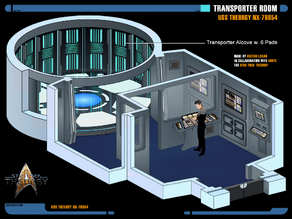
Transporter Room (Theurgy)
Transporter rooms [ ]
Including a dedicated transporter on the aft wall of the bridge, the Odyssey -class featured 7 Personnel Transporters and 5 Cargo Transporters with 6 Pads each as well as 4 Personnel Evacuation Transporters with 22 Pads each at strategic locations throughout the ship connected to a total of 22 emitter arrays on the exterior hull. These allow 40,000 kilometres of Instant Teleportation for multiple personnel and large amounts of cargo. Every Fighter includes an ETS (Emergency Transport System) a single-person, single-use, one-way emergency transport unit.
The Fighters have a built-in (ETS) in the cockpit, with a one-way pre-set location for their assigned Starship or Starbase. The Emergency transporter could be reprogrammed to send the pilot to a new location (chosen by the pilot) because of the possibility of long-range missions, but this system was best utilized if they sustained critical damage while defending their ship within Transporter range.
Starfleet created the class not only for exploration but to establish Bases and outposts quickly and much of the Odyssey classes design could be easily converted to cargo and Colony Carrier Areas allowing this class to essentially act as a Starbase facility. Now the UFP could stake claims to areas far beyond federation space, while also being able to construct outposts and provide protection for these areas until they were secured.
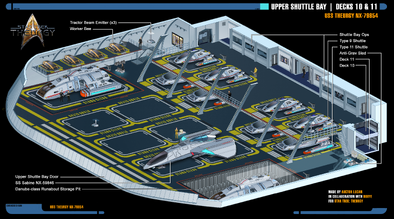
Odyssey Class Secondary Shuttlebay (Theurgy)
Shuttlebays [ ]
Similar to its Predecessor Starfleet vessels including the Galaxy and Sovereign Classes, the main shuttlebay of the Odyssey -class was situated on the aft rim of the saucer between its impulse engines. Odyssey classes also carried a secondary shuttlebay as was typical, although it was placed on the fore end of the engineering hull just above the Deflector Dish (The second Bay could be retrofit into a Fighter Assault Bay if Required) containing approx. 68 Auxiliary Vehicles of varying types between the 2 Flight Complexes.
At the aft of the secondary Shuttlebay are 8 Rapid Deployment Bays designed to allowing starships to quickly deploy Probes, Mines, Workbees, Communication Arrays and other equipment.
The Odyssey class also included a docking berth for a single Aquarius Class Light Escort. The Aquarius was named as a call back to NASA's Apollo 13 Lunar Module Odyssey and Landing Pod Aquarius. In late 2411 the Yorktown, Lexington and Endeavour Variations of the Odyssey Design replaced the Aquarius with updated Eagle Class Raiders based on acquired Terran Technical Schematics from the Mirror Izar Research Station.
The captain's yacht, are integrated craft of cruisers and were typically docked on the Forward Secondary Hull on Deck 19 just aft of the planetary sensor array. Use of the craft was left at the discretion of a vessel's commanding officer, with the intended purpose being for diplomatic, scientific, transportation, and personal use by said CO. On odyssey classes it would often take the form of a single Manta Class Advanced Scout.
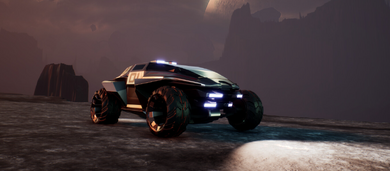
The Standard Offroad Starfleet Vehicle which replaced the Argo Buggy (Daniel Brainbox)
Land Vehicles were stored in the Shutlebays and Several cargo bays throughout the ship for Planetary Expeditions or Cargo Transfers. If required the Entire ship could Land on a Planetary surface or large enough Asteroid using retractable landing legs. Landing on a surface was usually used to set up permanent bases, resupply on raw materials, hide from pursuit, when transporters were inoperative, to perform intensive maintenance if a dry dock facility was unavailable, an Emergency Landing or at the ship's CO's discretion.
With appropriate modifications most Shuttles aboard could be altered to work in Water or almost any other environment including Fluidic Space. (The Engines were Modified, Micro Torpedoes were switched to Missile Versions, Phasers were tuned to be effective Underwater, Sensor arrays were optimized for undersea data collection, Flood Lights would be added and Hull or Shields could be altered in various ways allowing shuttles to withstand pressures of over 59,500 atmospheres and Shock Dangerous aquatic wildlife if threatened.
Embarked craft [ ]
- 14 Mark-3 Workbees
- 1 Manta Class Scout
- 1 Aquarius Light Escort/Eagle Raider
- 6 Yellowstone Runabouts
- 16 Mk III Valkyries
- 8 Tovarek Class FTR Drones

Mark 3 Workbee (bagera3005)
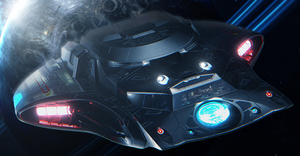
Manta Class Scout (Theurgy WIki)
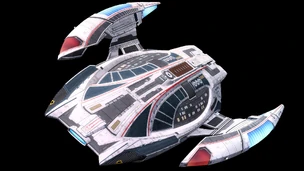
Eagle Class Raider
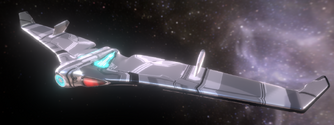
Tovarek FTR Drone (Theugy Wiki)
As well as 24 various shuttlecraft including Type 12 Shuttles, Type 14 Shuttles, Type 17 Shuttles and Type 18H Shuttles. In 2409 Odyssey Classes could be provided with 4 Experimental Quantum Slipstream Shuttlecraft with the authorisation of the Sector Commander.
To assist in Repairing Hull Damage and rebooting systems in Space, Odyssey Classes were equipped with 20-40 DOT-12 Automated Repair Robots. These could be controlled remotely for more delicate repairs using an Engineering PADD but usually worked Autonomously alongside external and internal Damage Control Teams.
Ships commissioned [ ]
Seen during 2401 Frontier Day
- USS Challenger (NCC-92421)
- USS Hikaru Sulu (NCC-92420)-Heavily Damaged
- USS Harmony (NCC-84002)
- USS Canopus (NCC-84001)
- USS Arcturus (NCC-84000)
- USS Ride (NCC-83721)
- USS Capella (NCC-83051)
- USS Sirius (NCC-80002)
- USS Polaris (NCC-80001)
- USS Odyssey (NX-79001)
- USS Enterprise (NCC-1701-F)-Retired
- USS Endurance (NCC-79003)-Heavily Damaged
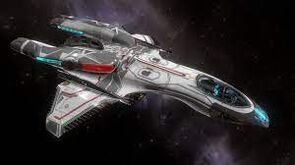
Mark-III Valkyrie

- USS Durham -A (NCC-70744-A)
- USS Canterbury (NCC-89594)
- USS Verity (NX-79000)-Retired
- USS Arcadia (NCC-97001)
- USS Valentine (NCC-97002)
- USS Enterprise -F (NCC-1701-F) (formerly, USS Endurance NCC-79003)
- USS Columbia (NCC-97004)
- USS Dennison (NCC-97005)
- USS Starfinder (NCC-97008)
- USS Keogh (NCC-97010)
- USS Deletham (NCC-97011)
- USS Gheryzan (NCC-97017)
- USS Republic (NCC-97019)
- USS Sisko (NCC-97024)
- USS Schicksal (NCC-97064)
- USS Spock (NCC-97070)
- USS Sahving Valley (NCC-97135)
- USS Marvel (NCC-97180)
- USS Sato (NCC-97216)
- USS Normandy (NCC-4309-B)
- USS O'Brien (NCC-97254)
- USS Atlantis (NCC-97256)
- USS Houston (NCC-97284)
- USS Nimitz (NCC-97404)
- USS London (NCC-97412)
- USS Hiplpeov (NCC-97413)
- USS Peacemaker (NCC-97420)
- USS Victoria (NCC-92748)
- USS Promethean (NCC-97027)
- USS Hikaru Sulu (NCC-92420)
- USS Archeron (NCC-79007)
- USS Endurance (NCC-79003)
- USS Endeavour (NCC-98500)-Refit to Endeavour Class
- USS Mol'ecurai (NCC-98501)-Refit to Endeavour Class
- USS Lexington (NCC-98355)-Refit to Yorktown Class then to Lexington Class
- USS Gheryzan (NCC-97017)-Refit to Yorktown Class
- USS Yorktown (NCC-98300)-Refit to Yorktown Class
- USS Ashalla (NCC-97135)-Refit to Sojourner Class
- USS Sojourner (NCC-98400)-Refit to Sojourner Class
Commanding Officers [ ]
- Admiral Jean-Luc Picard (USS Verity )
- Captain Va'Kel Shon (USS Enterprise )
- Vice Admiral Sysary (USS Deletham )
- Captain Radzen Tos (USS Geryzan )
- Captain Loreck Avery (USS Marvel )
- Captain Ryan Hale (USS Promethean)
- Marcus Alexander Slayton (USS Archeron)
Gallery [ ]
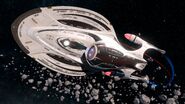
External Links [ ]
- Odyssey class article at Memory Beta , the non-canon Star Trek wiki.
- Odyssey class article at Star Trek Expanded Universe .
- Odyssey Dreadnought Cruiser article at The Star Trek Online Wiki .
- " Starfleet's New Odyssey: The Future of the Super-Capital Starship ," TTC Jayce's Navy Interstellar 244, no. 6 (Stardate 84208.8): 80-89.
- 1 Invincible class
- 2 William V of the United Kingdom
- 3 George VII of the United Kingdom
Odyssey Class
The Odyssey-class is a type of Federation starship that was the pinnacle of starship design and would carry Starfleet into a new generation of exploration in the late 24th century and well into 25th century. It was designed to be a dreadnought and an explorer. It is one of the largest starships created by Starfleet, surpassing even the Galaxy-class in size, in order to effectively compete with the larger Battleships and Dreadnoughts fielded by the Dominion and Romulan Star Empire.
Capabilities
Designed as the new flagship star cruiser for Starfleet in the 25th century, the Odyssey-class represents significant advancements in the tradition of Starfleet cruisers, but at an unprecedented scale. With a standard crew of 1,600, the Odyssey-class was designed to tackle any mission a Starfleet crew might be assigned to complete, be it diplomatic, scientific, or of a tactical nature. The state-of-the-art sensors are some of the most advanced ever developed by Federation science, and its impressive armament make it a match even for Dominion Battleships or Reman Scimitar-class Dreadnoughts when fought one-on-one.
The truly massive Yoyodyne 46A Warp Core provides ample power for engines, shields and weapons to be kept online nearly indefinitely assuming no undue stresses on the EPS grid. Furthermore, the Odyssey-class has a trick hidden up its sleeve; Multi-Vector Assault Mode inspired by the Prometheus-class Attack Cruiser. In MVAM mode, the saucer can detach and function as a small cruiser in its own right, while a smaller Aquarius-class escort can be launched from its bay in the rear of the vessel; offering tactical flexibility and providing a dedicated scout craft for use in situations deemed unsuitable for a Runabout.
Mission Profiles
The Odyssey-class is a true multi-mission craft. Like its predecessors it is capable of undertaking any mission assigned by Starfleet Command, from flagship and tactical duties to long-range exploration and diplomatic functions.
Image Gallery
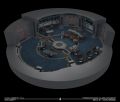
Vessels of Note
- ↑ Prototype
- ↑ Decommissioned, 2401
- ↑ Destroyed, 2401
- Engineering
Navigation menu
Personal tools.
- View source
- View history
- Administration
- Historical Archives
Star Fleet Resources
- Corps of Engineers
- Office of Intelligence
- Medical Command
- Applied Sciences
- Security Command
- Elite Joint Operations
- Tactical Command
Additional Tools
- Recent changes
- Random page
- What links here
- Related changes
- Special pages
- Printable version
- Permanent link
- Page information
- Cite this page
- This page was last edited on 31 March 2024, at 00:26.
- Privacy policy
- About Federation Space - Official Wiki
- Disclaimers
- Mobile view
Odyssey Class
The Odyssey -class heavy explorer is the largest starship in Starfleet service, serving as a frontline explorer and flagship with an emphasis on diplomatic and command capabilities. The ultimate expression of the Utopia Planitia school of starship design exemplified by the Galaxy -class explorer of the 2360s, the Odyssey has design features and aesthetics that harken back to a more hopeful era in Federation history. In service, she has complemented leaner, more efficient explorers, like the Ross and the Obena , by providing advanced long-range communications and command functions, engineering and technical support, and medical facilities once only found on starbases.
- 1 Exploration and Science
- 2 Diplomacy
- 3 Engineering
- 5 Auxiliary Craft Facilities
- 6 Shipboard Life
- 8.1 Project Odyssey
- 8.2 Construction History
- 8.3 A New Lease on Life
- 9 The Odyssey Class In -Play
Exploration and Science
As explorers, Odyssey -class starships are capable of independent exploratory missions of indefinite duration. In practice, however, they are typically not sent into deep space on their own. Rather, they serve as a logistics hub and flagship for a formation of other, smaller starships to increase their range with their own massive fuel and supply reserves. They also embark a fleet of small craft on their own for dozens of simultaneous away missions, including their Aquarius -class escort which can easily handle transporting away teams on independent scientific missions or serve as a temporary planetary camp for intensive studies. The primary and secondary hulls of the Odyssey can operate fully independently, allowing the ship to embark on multiple primary missions at the same time. For example, the secondary hull could be used to investigate an interstellar phenomenon while the saucer section conducts an in-depth survey of a nearby star system, all while the support ship is engaged in an archaeological dig, a capability not present with any other single starship.
Like the Galaxy , they have extensive onboard science departments with the full range of general, specialist, and mission-configurable labs, as well as substantial onboard space for science teams to conduct missions fully independent of the ship's primary mission. Odyssey-class ships have labs in every imaginable specialty and the scientists to crew them, as one of their core tasks is providing specialist expertise to other vessels that are too small or too specialized to embark their own. For example, it is rare for a starship to have an entire xeno-ornithology section onboard, but this and other extremely specialized departments are common on Odyssey-class ships.
Odyssey-class ships have four large probe bays which launch vertically from the bow. These launchers are capable of handling the very largest of Starfleet's probe inventory, including equipment that once had to be launched from shuttle bays. They also have the capability to manufacture probes onboard.
Starfleet is reluctant to assign Odyssey-class starships to general exploratory duties for the same reasons that make them excellent at that task: their large size and large crew counts. The disastrous first contact between the Galaxy -class USS Odyssey and the Dominion during her final mission is a well-remembered lesson. For truly independent exploration, Constitution III and Obena -class ships are preferred, particularly those where unexpected first contacts with potentially hostile powers are possible.
Because of their size, Odyssey -class starships are excellent diplomatic platforms. They can easily accommodate hundreds of visitors in guest quarters or host thousands of people as a sort of orbital conference center. They are well-suited to multi-party talks and hosting academic summits. Given their crew size, they almost always embark a dedicated diplomatic and protocol staff, something usually only seen on dedicated diplomatic couriers or starbases. They are generally only sent on the most important diplomatic missions, and Obena -class starships are often preferred for fist contact missions because of their less-intimidating nature.
Combined with her advanced communications system, Odyssey is capable of hosting negotiations in her holodecks with some guests connecting remotely, and all of her diplomatic spaces and quarters are fully reconfigurable using holographic technology. This equipment also keeps these ships in constant contact with Starfleet Command, allowing them to serve as an authoritative voice during negotiations. Odyssey-class ships are often themselves flagships, and the embarked flag officer is often the lead during diplomatic talks.

Engineering
Odyssey -class starships are incredibly complex vessels, given that, like the Galaxy before them, they are comprised of two separate, independent vehicles, each with their own life support, propulsion, defense, and crew support systems. The primary hull, dubbed the "chevron" joins to the secondary hull, with a set of magnetic latches. There are also pass-throughs the impulse engines, which are connected when the ship is integrated to allow the normally-hidden chevron engines to provide the main impulse engines with more power. The primary hull has its own warp core, which feeds a set of warp coils arranged in a horse-shoe pattern around the ship's separation plane on the underside of the chevron. It also contains four gimbaled warp governors that strengthen and enhance the ship's warp field, allowing it to travel at high speeds more efficiently. These governors are powered by the saucer warp core, meaning that the ship is at its most efficient when both hulls' power systems are in operation.
The ship's entire propulsion system can be controlled from either main engineering, featuring the intermix chamber for the ship's primary warp drive, or from the engineering complex in the saucer section, at the discretion of the ship's chief engineering officer. Advanced automation makes many tasks simpler, such as routine maintenance, but the ship's highly complex structure and internal arrangements means that the overall engineering crew required for normal operations is still very large. Other advanced systems include multiphasic radiator plates--which help disperse exotic particles created by sustained high-speed travel, and q-phase variance compensators which mitigate the effects of temporal and spatial distortions created by the unusually-powerful warp engines.
To fulfill their role as essentially mobile starbases, Odyssey -class ships are equipped with industrial replication facilities and onboard workshops to create any component to repair themselves and the ships they travel with. These facilities can also be used to build entire colonies or refugee facilities in service of their humanitarian mission. Coupled with large cargo holds, they can serve as the logistical centerpiece to entire fleets. The ship also has two heavy-duty forward and aft dual tractor beam emitters for manipulating large objects, and these are often useful in building large space stations.
Building off of lessons learned in the design of the Sovereign -class exploratory cruiser, Odyssey -class starships are well-armed and powerfully defended. Unlike the Sovereign , however, they are not intended primarily for tactical functions. Their weapons are distributed to provide even coverage on all angles, with more emphasis on powerful shields over forward alpha-strike capabilities. Few threat vessels could expect to successfully defeat her in a one-on-one confrontation - those able to endure sustained fire from her weapons systems are highly unlikely to breach her shields before she is able to disengage at a sprint speed difficult for them to match.
Odyssey ’s first line of defense is her impressive shield coverage, with regenerative shield generators of comparable size and redundancy to a small starbase. With two warp cores, she is able to keep her shields up longer and under more fire than most other starship classes. There is an ongoing refit program to add metaphasic shields to this class, as well.
The torpedo launchers aboard Odyssey are enhanced from those found aboard Galaxy , each capable of firing salvos of fifteen (rather than ten) photon or quantum torpedoes at a time. There are two forward and two aft launchers, providing three times the torpedo launch capabilities of the Galaxy and a similar capability to that of the Sovereign but with substantially fewer launchers, and thus lower maintenance demands. Given the right raw materials (namely antimatter), Odyssey-class ships are capable of manufacturing new torpedoes for their own arsenals and that of their support vessels.
Phaser coverage is comprehensive, with eighteen Type-XII phaser arrays (including two arrays only usable in separated flight mode) covering all firing arcs. In addition, there are two dorsal and one ventral phaser cannon turrets, which have internal rotary components to provide fast, responsive targeting to craft too close to target with the main phaser arrays. The primary hull has two heavy pulse phaser cannons, which are primarily used in separated flight mode to compensate for the primary hull's lack of torpedo launchers.
Whether in peacetime or in wartime, Odyssey’s mission parameters call for extensive communications facilities. With powerful active subspace arrays capable of cutting through nearly any other interference through sheer power, Odyssey is suited both to leading fleets and to coordinating exploration efforts from the front. On long-range missions, she serves, if not as the literal flagship for an expedition with an admiral embarked, as the coordination center through which communications traffic is filtered and distributed to vessels with more traditional communications arrays. These systems are also used to coordinate her extensive complement of embarked craft which are used to supplement her exploratory efforts.
Auxiliary Craft Facilities
Odyssey -class starships have the greatest small craft capabilities of any starship currently in service, thanks to a massive three-deck hanger in the primary hull and a second hanger in the secondary hull nearly equal in size to the primary facility found aboard Galaxy and Nebula -class starships. A typical Odyssey-class starship embarks a dozen runabouts and scouts, and three times that many shuttles. These craft are used to conduct away missions, ranging from weeks-long scouting trips away from the mothership to humanitarian evacuations. The primary hanger is split into three distinct bays, with two smaller doors flanking a larger middle door. The side bays also have upper and lower launch and retrieval pads, splitting them further in two for the first 30 meters of the bay. This allows for simultaneous launch and recovery operations to proceed on five different vectors from the main hanger. The secondary hull hanger is not split, which preserves the capability to house larger craft and bulky cargo.
To enhance her point-defense capabilities, Odyssey can also support a wing of twelve starfighters. Amidships in the secondary hull there are eight quick launch bays for small craft. These small bays can support a single fighter, shuttle, or maintenance craft for quick vertical launch, usually in combat situations. These bays are connected to the forward hanger via a maglev tunnel. Outside of combat it is possible for them to retrieve the craft they launch, but usually launched craft return through the forward shuttle bay.
The Odyssey supplements her already-impressive small craft capabilities by being the first design to embark a full-sized escort starship. Carried in a stern docking cradle, the Aquarius -class escort is similar in philosophy to the Defiant -class escort, but with greater space for cargo and away team support functions in place of some of her armaments. This vessel can be controlled directly from the Odyssey in multi-vector flight configuration or embark its own crew for fire support. It is also frequently used for independent missions, though she's not intended to be away from her mothership for more than three or four weeks at a time. In addition, Odyssey-class starships embark an integrated captain's yacht behind the primary planetary sensor dome in the secondary hull. These ships can be configured with a diplomatic launch, any captain's yacht class, a Waverider, or an Aeroshuttle, but altering this bay is a process that would take a starbase several weeks to accomplish, so once the selection is made, a ship tends to keep their integrated craft the same.
Shipboard Life
Odyssey is significantly larger than even other explorers and her crew enjoys a very high standard of accommodation. There are private sleeping accommodations for all crewmembers, though all personnel ranked ensign or lower share suites with varying numbers of bedrooms connected to common areas and sanitary facilities. Lieutenants and above have their own quarters. All crew members are allowed to combine their living quarters into one larger unit, should they so request. There are four extra-large suites spanning two decks that are reserved for the commanding officer, executive officer, and VIPs, which contain multiple bedrooms, an entertaining area, and a private study, all in the interest of giving senior officers on this very prestigious, stressful assignment adequate facilities to rest and recharge. All quarters aboard Odyssey are capable of being configured to meet any environmental need for a class M, L, K, O, or P, environment, with other configurations being possible with an additional life support module. Null-gravity and high-gravity configurations are also available.
Communal recreation spaces are plentiful on the Odyssey . There are several full-sized holodecks and smaller holosuites, all with the highest levels of holographic fidelity available. Recreation decks are available in both the primary and secondary hull with a wide variety of games and other entertainments. Fitness facilities are also comprehensive, with recreational and conditioning spaces appropriate for all species serving aboard the ship. An expansive arboretum deck is found in the saucer, along with two public pools. While configurations vary from ship to ship, there are many lounges spread throughout the ship. Some Odyssey -class ships have promenades on the edge of the chevron section, as well as an atrium area with restaurants staffed by holograms. These facilities are designed to be used by the crews of other ships as well, and give the feeling of being back at a starbase.
Medical facilities are extensive, rivaling starbase hospitals. Identical sickbay complexes in the two hulls offer ward space for several dozen intensive care patients, private rooms, and specialist facilities. All of the guest quarters can be used as additional private patient rooms, if necessary, and the holodecks are also useable as medical facilities. They support other ships with medical specialists such as cyberneticists, reproductive healthcare practitioners, and other specialist less commonly found on starships.
The minimum staffing level for an Odyssey -class ship is 1,600 crewmembers. Many Odyssey -class ships operate with significantly larger crews, especially with additional science and engineering personnel, and the most common arrangement is for a permanent crew of 2,500 supported with additional visiting specialists as necessary. If needed, an Odyssey -class ship could embark a permanent crew of up to 5,000, but this would test the limits of even this ship's size and would reduce her humanitarian capabilities. The large crew sizes aboard ships like this mean that there's often less a sense of family for the crew as a whole, and more attachment to one's departmental colleagues. Vessels of this class often have many high-ranking officers.

Class History
Project odyssey.
Nearly as soon as the first Galaxy -class explorers left Utopia Planitia, the Advanced Starship Design Bureau began thinking about their eventual successor. The Utopia Planitia School of astronautical architecture had lobbied for decades for ever-larger vessels. The Ambassador had been a revolution in both hull and engine design, moving a substantially larger mass than the Excelsior at substantially greater speeds. The Galaxy took that further, being both larger and faster than the Ambassador while carrying the first thousand-person crew in Starfleet history and being among the first designs specifically designed to allow Starfleet officers to bring their families with them on long voyages, with a level of comfort never before seen on a starship.
The Galaxy successor project, originally dubbed Project Nova, faced dramatic cuts in 2365 with the destruction of one of the Galaxy prototypes, the USS Yamato with all hands. First contact with the Borg and the subsequent battle of Wolf 359 later that decade led Starfleet to question the wisdom of building ever-larger starships that would put so many eggs in one basket. Project Nova and the related Project Intrepid programs led to lean, smart starship classes designed to counter this problem by handling exploratory tasks with minimal crews. Wolf 359 also spawned Project Sovereign, which was initially billed as a Galaxy successor program but resulted in a more compact, much more heavily armed vessel to suit the times.
By 2371, three of the original six Galaxy-class explorers had been lost in combat, putting the concept further into question. During the Dominion War, all talk of another large explorer class was put on hold as the Corps of Engineers focused on activating as many Galaxy and Sovereign spaceframes as possible. When the war ended, however, there was renewed interest in creating a vessel that might finally be able to realize the vision at the core of Project Galaxy. Named for one of the lost Galaxy -class ships, Project Odyssey began at Utopia Planitia in earnest even as Starfleet began to pick up the pieces in 2375. There was significant push-back to this project, however, as many admirals believed that the future was not in building even larger ships than the Galaxy but in optimizing its design to allow a smaller crew to explore further. Thus, Starfleet Command authorized a design team at the Beta Antares Fleet Yards to commence a competing project, Project Obena.
The team at Utopia Planitia began by identifying the underlying causes behind the destruction of Yamato , Odyssey , and Enterprise . It was ruled that the was no underlying design flaw that was responsible for the loss of Yamato , due to Iconian influence. Odyssey's loss was due to the vulnerable interconnecting dorsal section being insufficiently armored and shielded, as well as the ship being vulnerable to small attackers at close range. Enterprise was lost for similar reasons, but it was found that without having found her shield frequencies, the Klingon bird of prey would not have been able to destroy her. During their analysis, the team identified these priorities for Project Odyssey:
- Odyssey must be at least as well-armed as Sovereign, with a particular emphasis on decreasing vulnerability to smaller, more maneuverable threat vessels.
- Odyssey must retain the saucer-separation ability developed for Galaxy, with the primary hull capable of returning to a starbase with an independent warp drive system.
As the design process matured, a hull shape emerged that blended features from the Galaxy and Sovereign , and these lessons were incorporated to the Ross -class explorers, a project intended to finish out the remaining Galaxy production orders with tactical and automation enhancements to solve some of the issues with the original class. This also provided the Project Odyssey team with a chance to test some of their ideas. In 2379, the design matured to the point where Starfleet was comfortable placing an order for three vessels, while also placing an order for Obena -class vessels.
Construction History
Odyssey , Verity , and a third unnamed vessel began construction in 2379 at Utopia Planitia. Production proceeded more quickly on these vessels than the Galaxy because of lessons learned in the construction of large ships during the Dominion War, but their launch was not expected until around 2385. Fate would deal Project Odyssey a curve-ball, though, when Starfleet joined the Romulan Evacuation Mission in 2381. All of Utopia Planitia's resources were shifted towards building evacuation vessels. Odyssey and Verity were completed sufficiently to allow them to be space-worthy, so Starfleet ordered them to be filled with habitation modules to move refugees. Admiral Picard raised his flag in Verity and led the evacuation mission starting in that same year. The third ship was substantially less complete, and it was transferred to the Beta Antares Fleet Yards--ironic given that this yard was also building her Obena -class competitors.
When Utopia Planitia was destroyed in 2385, the evacuation mission was cancelled. The third Odyssey-class ship was nearing completion and the decision was made to fit her out with her original specifications. Odyssey and Verity also returned to dock for the same treatment. The third vessel, now the seventh Federation starship to bear the name Enterprise , launched in 2386.
A New Lease on Life
With Starfleet rapidly pivoting towards an isolationist stance in response to the attack, and with the C entury now also in service, the future of this class was in doubt. The three prototypes faced intense scrutiny throughout the end of 2380s, and were found to be highly effective in service. In a twist of fortune, it was actually the Beta Antares team that lobbied for the renewed production of the Odyssey alongside their own design, as the two designs complemented each other well--the Odyssey could support an entire fleet and bring on large visiting science teams for extended missions, while the Obena could be built in larger numbers and support similar exploratory missions with a smaller crew.
The design was further refined to incorporate aspects of the Prometheus -class heavy escorts also developed at Beta Antares, notably the ability for the entire ship and the embarked escort to be controlled in multi-vector flight mode by just one of the bridges. A further nine Odyssey -class ships were ordered at yards around the Federation to bring their numbers up to an even dozen. As is often the case, however, few Odyssey or Obena -class ships did much exploring beyond the Federation's borders in the 2390s, due to Starfleet's continued prioritization of border security, but the two classes operating in concert were able to survey large portions of Federation space that had never before been explored. The Odysseys also found themselves frequently used for diplomatic and humanitarian functions more than in purely exploratory roles.
With the nature of the attack on Utopia Planitia finally understood in 2399, Odyssey -class ships began embarking on longer missions away from Federation space. In early 2401, several ships of this class were upgraded to include key components of the controversial Fleet Formation Mode, a natural extension of their multi-vector flight mode.
The Odyssey Class In -Play
- Odyssey -class starships are very large, both in terms of their physical bulk and the size of their crews. While her Sovereign and Obena -class cousins were developed as more-capable successors to the Galaxy -class by slimming down and increasing efficiency, the Odyssey -class was designed with the opposite thinking in mind: comprehensive facilities and large crews to make humanitarian and diplomatic operations easier.
- Because of the crew’s large size, there will always be a larger number of very senior officers aboard these ships. During James T. Kirk’s final years in command of the Enterprise -A, the ship’s command staff included two other officers holding the substantive rank of captain as first officer and chief engineering officer, and this is a scenario that’s very likely for a ship of this size. Modern aircraft carriers are another model for command structures that include multiple officers with this very senior rank, and so it’s an opportunity to imagine what the dynamics of a crew might be that is over twice the size of the crew we saw on Star Trek: The Next Generation .
- Odyssey -class ships are an exceptionally-prestigious assignment at any billet, but especially for captains. Because commodores and admirals rarely exercise direct control over a starship, their flagships often have a flag captain who is nominally in command of the vessel itself, but who themselves are relatively junior. Ships not assigned as flagships would be assigned to very senior captains or fleet captains for extended long-range exploratory or diplomatic missions.
- An Odyssey -class ship could be the basis for a game with a lot of departments not normally found aboard smaller ships, such as JAG, an embarked civilian diplomatic delegation, a Starfleet Corps of Engineers team, etc. Its size presents numerous opportunities for playing with norms we've seen on the shows. The Odyssey is as revolutionary (in terms of its size and facilities) as the Galaxy was before it, so characters will be impressed to be aboard one
- Sovereign -class ships are a superior choice for deep space tactical missions, as well as any scenario where the ship is expected to engage in extended periods of combat independently. The Odyssey -class’s support ship and powerful shields make it a challenge for all but the most determined aggressors, but she wasn’t designed to lead offensive actions of her own.
- Constitution III -class ships are superior choices for extreme long-range solo missions. While the Odyssey -class is perfectly capable of long missions, her facilities are geared to coordinating and supporting other starships, and so her capabilities would be wasted on independent missions.
- Bravo Fleet Canon
- Specifications
- Federation Starship Classes
- Heavy Explorers
- Playable Federation Starships
- Federation Starship Classes (2385–2397)
Odyssey-Class
- Edit source
The Odyssey -class was a type of Federation starship that was the lead type of Starfleet explorer vessel in the early 25th century.
Features [ ]
The Odyssey -class is actually divided into four sub-classes, the Odyssey star cruiser, the Odyssey tactical cruiser, the Odyssey operations cruiser and the Odyssey science cruiser.
The Odyssey -class features the ability for saucer separation much like the Galaxy-Class . The saucer section, known as the Chevron section, can be separated from the stardrive section, allowing greater maneuverability to the stardrive section. The Chevron section can be reattached to the stardrive section at any time.
The pinnacle of the Odyssey -class's technological achievement is the advanced quantum slipstream drive carried aboard all Odyssey -class vessels. The advanced quantum slipstream drive propels the Odyssey -class to its fastest speed,

bridge layout 1
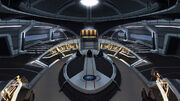
Bridge Layout 2
transwarp 34.71.
Known ships [ ]
- USS- Enterprise-NCC-1701-G

Continuing Mission

Ships of Star Trek Online: Odyssey-class Starship
INTRODUCTION: I’m a gamemaster for a Star Trek Adventures series set in the Star Trek Online setting. Occurring roughly 25 years after the events in Star Trek: Nemesis, the Star Trek Online setting introduces new conflicts with the Klingons, the Romulans in the wake of their homeworld’s destruction, the Borg, and others. In this era of increasing conflict, Starfleet officers must defend the Federation while continuing to explore strange new worlds and upholding the values on which the Federation was founded. In order to bring life to this campaign setting, many people in the Star Trek Adventures subreddit , myself included, developed statistics and overviews for the new ships included in Star Trek Online.
The Ships of Star Trek Online series begins with the Odyssey -class starship, designed for Cryptic Studios by Adam Logan based on a submission by Adam Ilhe. The Odyssey -class U.S.S. Enterprise, NCC-1701-F, first appeared during Star Trek Online’s second anniversary event in 2012.
OVERVIEW: First conceptualized in 2404, the Odyssey-class starship was envisioned as an extension of the Constitution-class design lineage of a large, multi-role cruiser. Due to its size and power, the Odyssey was classified as a dreadnought. In peacetime, it serves the role of an explorer on long-term deep-space missions. In wartime, the class acts as the hard-hitting core of large starship formations, though it can also conduct solo operations. The Odyssey-class ship has an optimal crew of 2,100 and can also comfortably carry crew members’ families during peacetime.
CAPABILITIES: The Odyssey-class starship is designed to maintain a slender subspace profile, and its warp core is both larger and more efficient than that used for the Galaxy-class ship of the previous generation. This allows the ship to maintain a cruising speed of Warp 8 and an emergency warp speed of Warp 9.994. It is also fitted with an advanced quantum slipstream drive, first tested on the USS Voyager and later installed on Vesta-class starships. While the slipstream drive cannot be maintained for more than a few minutes, it allows the Odyssey¬-class ship to traverse the entirety of Federation space or travel thousands of light-years in a matter of minutes.
Like the Galaxy-class cruiser, the Odyssey-class starship can separate its primary and secondary hulls, allowing it to evacuate family members during an emergency or use multi-vector assault tactics against enemy ships during military operations. Each section carries batteries of Type XIV phaser arrays and multiple torpedo launchers, typically equipped with a complement of 250 quantum torpedoes.
DEPARTMENTS (YORKTOWN-CLASS SCIENCE VARIANT)
Departments (sojourner-class operations variant), departments (endeavour-class tactical variant).
- Phaser Arrays
- Quantum Torpedoes
- Tractor Beam (Strength 4)
TALENTS: All Odyssey -class ships have the following Talents:
- Improved Hull Integrity
- Command Ship
In addition, Odyssey -class ship captains may select the Saucer Separation Talent.
MORE RESOURCES: Odyssey- class starship, Memory Beta Jayce’s Navy Interstellar, Vol. 244, Issue 6 Dev Diary: Design the Next Enterprise, StarTrek.com
Share this:
6 responses to “ships of star trek online: odyssey-class starship”.
I really enjoyed this post!
Thanks so much!
Wow! I really enjoyed reading about your take on this ship!
Nice just wish you made pdf file so can download the stats
No mention of the Aquarius Escort vessel that can dock to the ship’s aft end? Being able to deploy a defiant style warship as a force multiplier is certainly an interesting option.. and one that IMO makes more sense than MVAM.
Another question: shouldn’t the Tractor Beam rating be at least Strength 5 if this ship is Scale 6?
Leave a Reply Cancel reply
This site uses Akismet to reduce spam. Learn how your comment data is processed .
Discover more from Continuing Mission
Subscribe now to keep reading and get access to the full archive.
Type your email…
Continue reading
Odyssey class
- VisualEditor
- Odyssey Star Cruiser
- Odyssey Operations Cruiser
- Odyssey Science Cruiser
- Odyssey Tactical Cruiser
- Endeavour Tactical Star Cruiser
- Sojourner Operations Star Cruiser
- Yorktown Science Star Cruiser
- Legendary Verity Command Dreadnought Cruiser
- Terran Lexington Dreadnought Cruiser
- Class overview
- U.S.S. Enterprise -F
- Odyssey Dreadnought Cruiser
- Terran Odyssey Dreadnought Cruiser
- Flagship Technologies Console Set
- Odyssey Cruiser Set
The Federation Odyssey -class starship is a set of starship classes which include the U.S.S. Enterprise -F as its most famous craft. See the template to the right for a list of playable starships and NPC mobs in Star Trek Online based on the Odyssey. Most have interchangable parts within the two groups.
- 2.1 Odyssey -class variants
- 4 External links
- U.S.S. Columbia
- U.S.S. Odyssey
- U.S.S. Houston
- I.S.S. O'Brien
- I.S.S. Odyssey
- I.S.S. Sato
- I.S.S. Sisko
- I.S.S. Spock
- I.S.S. Enterprise
Stats [ | ]
Odyssey -class variants, notes [ | ].
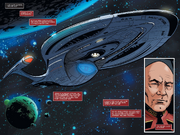
The Odyssey's inclusion in the Star Trek: Picard prequel comic
- The Odyssey class was designed by Adam Ihle, winner of Cryptic Studios' Design the Next Enterprise contest.
- The Odyssey was included in the prequel comic for Star Trek: Picard in the form of the USS Verity ; set several years before Star Trek: Online.
External links [ | ]
- Building the Next Enterprise
- Odyssey class at the Official website
- 1 Ancient Obelisk Technology Set
- 2 Playable starship
- More to Explore
- Series & Movies
Published Jul 20, 2011
Dev Diary: Design the Next Enterprise
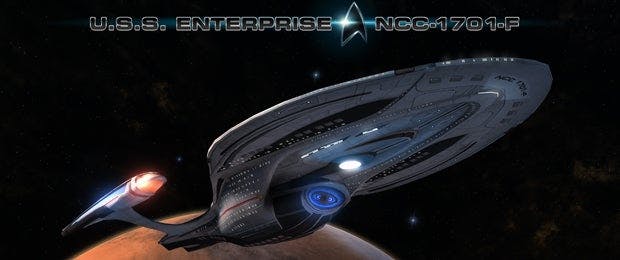
Please join StarTrek.com in welcoming our newest blogger, Daniel Stahl, executive producer for Star Trek Online , who, in his first piece, gives us an inside look at the final version of the latest U.S.S. Enterprise , based on a fan-submitted entry that won Cryptic’s Design the Next Enterprise contest.
The Christening
The day has arrived -- and we are happy to reveal the final version of the winning ship from our Design the Next Enterprise contest. We present to you the fan-designed U.S.S. Enterprise-F, a new Odyssey-class starship built in a time of war to act as the flagship for Starfleet and the Federation . Originally submitted by fan Adam Ilhe, the design was finalized by the Starfleet Corps of Engineers at the San Francisco Fleet Yards.
The new Odyssey class represents the next stage of Starfleet Cruiser design, emphasizing stability and firepower while allowing for versatility in exploration. In the Star Trek Online timeline of 2409, the galaxy is embroiled in war with numerous threats to peace and stability. This Enterprise is designed to carry a message of peace, as well as to show the strength of resolve that forms the foundation of the Federation.
Reflections on the Design
Adam’s sketch inspired us. It created internal discussions about the evolution of the Starfleet Cruiser and how this ship represented a new approach to design that would lead us into the future. The silhouette remains familiar and recognizable, yet the ship offers an evolution in design that adds both beauty and function worthy of the name Enterprise.
With twin necks and sleek curves, this vessel is larger than any previous Enterprise. It represents an overwhelmingly beautiful presence and is an inspiration to the fleet. With slight bows to the neck and nacelles, this ship flows through space with purpose. We’re thrilled to have brought this design to life and feel that the final render elegantly captures in high detail the spirit and flow of Adam’s original.
Future Forward for the Enterprise-F
Now that the ship has entered service, it will be revealed to players in an upcoming Star Trek Online Feature Episode in which players will be able to see the ship in action and meet some of this ship’s new crew members. In addition, player captains will soon have a chance to earn their own Odyssey-class ship so that they can experience the power and grace of this ship for themselves.
Stay tuned as the U.S.S. Enterprise-F enters the Star Trek Online universe and makes itself known. We would like to give a huge thank you to all the fans that contributed to this contest and to the ongoing support for the game. We look forward to the future together.
And last but not least …
A very special thanks to Adam Ilhe. You have a wonderful imagination and your ship is beautiful.
-------To read previous entries in our Design the Next Enterprise Dev Diary series and to see earlier iterations of the Enterprise F as it morphs from concept into Star Trek Online starship, visit our Building The Next Enterprise page , which also includes information on how you can download and play the game.
Daniel Stahl is Executive Producer for Star Trek Online
Get Updates By Email
Odyssey class
- Edit source
The Odyssey class was a type starship introduced by the Federation Starfleet in the late 24th and early 25th century . Designated as an explorer or star cruiser type vessel, the class had several configurations which focused on either tactical , science or operations functions. By 2410 , multiple configurations and subclasses were also in service.
Like the older Galaxy class , the Odyssey class was able to separate its primary hull from secondary hull , providing the stardrive section with greater maneuverability once the chevron was away. The Odyssey class was also equipped with quantum slipstream drive . ( Star Trek Online )
After the class ship, the next vessel commissioned was the USS Enterprise -F , commissioned in 2409 . ( Star Trek Online mission: " Boldly They Rode ")
One variant of the operations configuration was in service by 2430 as a carrier . It was designed in an attempt to counter Klingon and Hydran fleet carriers of the era. The prototype of the carrier version was the flagship of Task Force 17 when it was launched in 2430 . ( Star Trek: United Federation of Munchkin Amazons )
- 1.1 See also
- 1.2 Mirror Universe
- 1.4 External links
Appendices [ ]
See also [ ], mirror universe [ ].
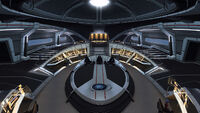
External links [ ]
- Odyssey class article at Memory Beta , the non-canon Star Trek wiki.
- 1 Daniels (Agent)
- 3 Interceptor class
Odyssey class
- Edit source
The Odyssey class was a type of Federation starship that was the lead type of Starfleet explorer vessel in the late 24th century and well into the 25th century. It was designed to be a dreadnought and an explorer. It is one of the largest starships created by Starfleet , surpassing even the Galaxy -class in size. ( STO video game: Star Trek Online ; PIC novel: The Last Best Hope )
- 2.1 24th century
- 2.2 25th century
- 2.3 26th century
- 3 Known ships
Features [ ]
The Odyssey -class featured the ability for saucer separation much like the Galaxy -class . The chevron-shaped saucer section could be separated from the stardrive section, allowing greater maneuverability to the stardrive section. The chevron section can be reattached to the stardrive section at any time. In addition, an Aquarius -class escort ship is docked to the rear of the ship's stardrive (roughly where the secondary shuttle bay would be located on a Sovereign -class ), which can be deployed at will. It also carries six workbees in the main shuttlebay for field repairs.
The pinnacle of the Odyssey -class's technological achievement was the advanced quantum slipstream drive carried aboard all Odyssey -class vessels. The advanced quantum slipstream drive propelled the Odyssey -class to its fastest speed, transwarp 34.71+.
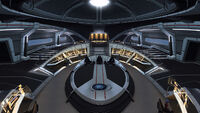
The bridge of an Odyssey -class starship, facing aft
The bridge of the vessel is cavernous and features a viewscreen separate from the forward viewport, with crew stations in an oval around the chairs for the commanding and first officers. The captain's ready room is on the starboard side of the bridge, with a turbolift on the port wall and a dedicated transporter pad set into the aft wall. There is an observation deck by the forward viewport and a second, partial crew deck down a flight of stairs. ( ST video game: Star Trek Online )
Service history [ ]
24th century [ ].

The USS Verity in 2385

The Enterprise -F over Mars
By 2381 the USS Verity was launched and was assigned as Admiral Jean-Luc Picard new command to help evacuate the inhabitants of the Romulan Star Empire from the areas that would be affected by the Hobus Supernova. ( PIC novel: The Last Best Hope )
25th century [ ]
The prototype USS Odyssey was launched in 2409 and taken on a trial cruise by one of Starfleet's leading captains . The first stage of the test involved scanning a group of satellites. During the subsequent weapons testing stage they attacked and destroyed a group of derelict Borg ships set up as targets.
At that moment a Klingon dreadnought arrived in Mars orbit. The captain took the ship after it and attacked the vessel, eventually inflicting severe enough damage to force them into retreat. ( STO mission: "The Odyssey Class")
Starfleet began producing three additional variants of the class shortly afterwards. The Odyssey switched from its initial NX registry to NCC-97000. ( STO - Klingon War mission: "Welcome to Earth Spacedock")
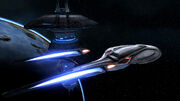
An Odyssey- class starship near Earth Spacedock
As the newest, most advanced class in the fleet, it was fitting that the seventh Federation flagship and the eighth iteration of the starship Enterprise be one of them. The USS Enterprise -F was launched later in 2409 under the command of Captain Va'Kel Shon. The Enterprise's first mission was to lead Starfleet reinforcements to Deep Space 9 to aid in the starbase's recapture from Dominion forces under First Kar'ukan. ( STO mission: "Boldly They Rode")
Odyssey -class vessels were also sighted under the command of the Terran Empire during their inter-universal attack on Vauthil Station. This included the ISS Enterprise -F . ( STO mission: "Mirror Invasion")
The ISS Enterprise -F was the flagship of the Terran Empire in 2409, and under the command of the recently promoted Admiral Leeta . When Imperial Starfleet forces from the 29th century arrived in the 25th century to turn the tide against the Iconians, Leeta insisted that the Imperial flagship be the first vessel to be outfitted with the uptime technology. ( STO - New Dawn mission: "Message from Another Universe")

Odyssey and Yorktown -class
During the Second Battle of Earth between the Khitomer Alliance and Dominion against the Iconian Empire in 2410, the Odyssey -class USS Yorktown (NCC-97005) was destroyed, and the Enterprise suffered extreme structural damage. Towed to Mars for service, the Starfleet Corps of Engineers rebuilt the Yorktown hulk into an upgraded, "Block II" version of the Odyssey class. The new Yorktown was recommissioned with the registry number NCC-98300. Starfleet relaunched the Enterprise as a Yorktown -class starship. ( STO - Emergence short story: "Jayce's Navy Interstellar: Through the Valley")
The Advanced Starship Design Bureau at the Utopia Planitia Fleet Yards developed two additional variants of the Odyssey , the Endeavour and Sojourner -class star cruisers. While the former was a more angular, military-oriented version, the Sojourner was geared towards exploration and featured a wide, circular saucer section. ( STO mission: "First Contact Day")
In 2410, Admiral D'Vak, Worf's grandson, commanded the Odyssey -class/"Block I" USS Houston . The Houston was destroyed during a battle with the Borg Queen and her forces at Unimatrix 0047. ( STO - Borg Advance mission: "Hive Onslaught")
Following the Battle of Excalbia on stardate 84999.22 in early 2411, which saw the prominent involvement of hero ships from the Federation's past and present, the Verity was among the command dreadnought cruisers that received a refit to legendary starship qualifications. Re-categorised as a Verity -class starship, the Verity carried the registry number NCC-97005. ( STO website: Legendary Command Dreadnought Cruiser )
The Khitomer Alliance partners also operated the Lexington -class dreadnought in 2411. This Terran dreadnought cruiser was based on the Yorktown class, or "Block II". The ISS Enterprise -F was refitted to this configuration. ( STO - Terran Gambit mission: "Red Shift")
The USS Enterprise -F and ISS Enterprise -F led a joint fleet to Pahvo in the mirror universe to stop the machinations of Wesley Crusher , Emperor of the Terran Empire . ( STO - Terran Gambit mission: "Eye of the Storm")
26th century [ ]
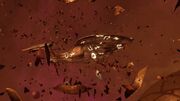
Odyssey -class wreck in 2554
The class remained active into the 26th century. In 2554, at least one Odyssey -class star cruiser was wrecked during the pivotal Battle of Procyon V between the Federation, the Sphere Builders and their Temporal Liberation Front allies. This ship was part of the Federation fleet led by the USS Enterprise -J .
In one course of events, Admiral Leeta brought the ISS Enterprise -F from the 25th century to Procyon V. The Enterprise -F fought the Enterprise -J. The time travelling Odyssey -/ Yorktown -class vessel was a match for the Universe -class temporal dreadnought cruiser. A boarding action by Admiral Leeta and Imperial Starfleet was repelled by Captains Pavel Chekov and Montgomery Scott . ( STO - Future Proof mission: "Ragnarok")
Known ships [ ]
- USS Odyssey (prototype, NX-97000)
- USS Enterprise (NCC-1701-F)
- USS Houston (NCC-97284)
- USS Dennison
- USS Yorktown (NCC-97005)
- USS Yorktown (NCC-98300)
- 1 Amanda Rollins
- 2 Declan Murphy
- 3 Monique Jeffries
- Cast & crew
- User reviews
Star Trek: Odyssey

A Star Trek fan production based on the Homer's The Odyssey telling the story of a spaceship trying to go home after getting lost in the Andromeda Galaxy. A Star Trek fan production based on the Homer's The Odyssey telling the story of a spaceship trying to go home after getting lost in the Andromeda Galaxy. A Star Trek fan production based on the Homer's The Odyssey telling the story of a spaceship trying to go home after getting lost in the Andromeda Galaxy.
- Brandon McConnell
- Michelle G. O'Neil
- Julia Morizawa
- 4 User reviews
Episodes 10

- Lt. Cdr. Ro Nevin …

- Sub Cdr. T'Lorra …

- Lt. Maya Stadi …

- Dr. Owen Vaughan …
- Ensign Josh Gillen …
- General Morrigu …

- Grand Majan …
- Lt. Alex Wozniak

- Ensign Kristen Laws …
- Klingon Tactical …

- Corey Aster …
- Chief Hars Bixx …
- All cast & crew
- Production, box office & more at IMDbPro
More like this

User reviews 4
- jonnithomas
- Jul 16, 2015
- How many seasons does Star Trek: Odyssey have? Powered by Alexa
- September 1, 2007 (United States)
- United States
- Official site
- Hidden Frontier Productions
- See more company credits at IMDbPro
Technical specs
Related news, contribute to this page.

- See more gaps
- Learn more about contributing
More to explore
Recently viewed.
How Star Trek Online Revived Gaming History For Its New Ships
Star Trek has a long, weird history with video games , as a franchise that has spent a long time struggling to balance the scales between delivering an authentic Star Trek experience and delivering… well, what people actually want out of a video game. There’s been plenty of attempts, and plenty of successes over the years, but one of the most enduring of all is the MMORPG Star Trek Online . And now, it’s paying tribute to some of that gaming history by bringing a trio of new ships to players’ armadas.
Launching in the game on PC today–and arriving on Playstation and Xbox versions next month on August 22– Star Trek Online ‘s new “Heritage Ships” bundle revives 3 unique Starfleet designs from a trio of beloved Star Trek games from the turn of the 21st century. Including the U.S.S. Typhon and the Valkyrie Mk. II fighters from Star Trek: Invasion , the Premonition from Star Trek: Armada , and the Achilles from Star Trek: Deep Space Nine: Dominion Wars , the new ships are a chance for Star Trek Online to pay homage to the legacy of Star Trek ‘s gaming history, even as itself finds its own original ship designs being brought into prime Star Trek continuity in recent years, like Star Trek: Picard ‘s canonization of the Odyssey-class Enterprise -F in its final season.
Check out a new trailer showcasing the ships and their unique abilities, inspired by their own individual games, below!
“You might frame it as abusing my power, but I wanted to take the opportunity–without having to justify myself to anyone else,” STO Art Director Thomas Marrone told io9 over Zoom recently about why now was the time to bring the the Typhon, Premonition, and Achilles-class ships into the game. “There’s a lot of people out there who love these old games, and who love these ships. What is Star Trek Online but a watering hole for all these amazing Star Trek ships, and Star Trek concepts and stories?”
Marrone’s hankering nostalgia for Trek ‘s gaming history came at a perfect time in Star Trek Online ‘s production cycle. Now more lockstep with the world of Star Trek media than ever before–there was a time, many years ago, when the thought of new canon Trek material appearing in the game was a twinkle in the mind’s eye, now, STO gets regular updates bringing ships from the latest shows to the game on a regular basis–as on-screen Trek found itself in a quiet moment, STO had a chance between releases to dig into the past.
“We just had Discovery season five ending, and we’ll be incorporating some of that stuff eventually as we always do,” Marrone continued. “We had a kind of window here between Lower Decks [season 5], and Prodigy [season 2] just came out too–we don’t typically like to add or even like to develop things for STO until we’ve actually watched the episodes ourselves, because we want to make sure that what we’re adding to the game reflects exactly what you see on screen. Really the only way we can do that is to watch the shows after they’ve come out, which is why there’s a bit of a trailing.”
“So we had a really nice window where we didn’t have anything super pressing from the shows that we needed to get in. What do with this window? And I thought ‘Hey, let’s take advantage of that and get some these classic Star Trek game ships. We’re calling it the Heritage Starship Bundle: that was the most concise way we could put that these are ships from classic Star Trek video games and that we’re honoring their legacy with what we’re doing in STO . That was really important to me, as someone who’s a fan of those games too.

One of the releases in the bundle is of particular interest to one STO player: James Swallow, the writer of Star Trek: Invasion who helped craft the crew of the U.S.S. Typhon and the ship itself for the game nearly two and a half decades ago. “It’s crazy for me to think that a game that I worked on nearly two and a half decades ago still has a fanbase, still had love for it. That was really, really cool,” Swallow told io9. “When the guys at STO reached out to me and said ‘oh, we’re gonna bring it back, I was immediately excited about the idea because [the Typhon ] was such a unique design for a ship, such a fun project to work on.”
In Invasion players were cast as Ensign Ryan Cooper, a pilot in Typhon ‘s Red Squad, a wing of Valkyrie-class fighters assigned under Worf’s command on the carrier vessel: a hulking brick of a design that was almost unlike anything fans had seen from Starfleet ships before. “ [ Invasion ] was the very first video game project I ever worked on, the first Star Trek video game for a Sony console as well,” Swallow added. “We broke a lot of new ground with that project, and I have a lot of love for it. The design was so cool, and then seeing it reinvigorated and brought back to life, it’s just amazing. [In Invasion ], it has that kind of fuzzy look to it, it looks like it’s been taken through a soft focus lens, and then here it is in stone, sharpened focus.”
“It’s the ship that we always wanted it to be, it’s the design that was always there, that if we could have done it back in that era in the Playstation, we would have,” Swallow reminisced. “But now seeing it, it’s just amazing. I can’t wait to get my hands on it and just kind of tool around–I play STO on and off myself, and I tend to ‘unplay’ the game. I won’t do any of the missions, I’ll just noodle around in my ship, listen to the sound effects. I’m going to go to DS9 for fun and just kind of be a tourist in that world for a little while!”
In bringing in not just the Typhon , but also the Achilles and the Premonition to the game STO ‘s art team had to find a way to not just balance the aesthetic of classic ’90s-era Star Trek with the design language of its own early 25th century setting, but make sure they were being faithful to designs that were being made with much, much older hardware in mind. “One of the things that Dave Blass, the production designer on Star Trek: Picard said that I really loved was that he doesn’t see Star Trek as a science fiction show: he sees it as a period piece, the period just happens to be 200, or 400, years in the future” Marrone said of the process of bringing these new ships to life again. “We’re bringing [these ships] into Star Trek Online , and so we’re adding detail–these games were Playstation One, or early PC era gaming. The models weren’t super detailed. So we definitely add details, but we’re trying to drill down on the intent [of the designs].”

For Marrone, this process is as much restorative as it is anything else. “The analogy I use is sort of wiping the grease off the lens to bring it into focus. The shapes, the silhouettes are all exactly the same, and if there are details there, we honor them and incorporate them. But then we’re like ‘well, what if ILM built this model? How would they do it, what would they want it to look like?’ It still looks like that ship, it still has the same material treatment, it still feels of the same era that that ship was created for. We did the same thing with the Achilles and the Premonition . We made [the Achilles ] look just like it looked in Dominion Wars , but, you know, plussed it up a bit. I want to shout out Tobias Richter, who did the Typhon and the Achilles models, he did a great job.”
But that doesn’t mean some ships in the bundle didn’t have opportunities for the art team to go beyond what came before. “We hired Eric Henry, who has a wonderful YouTube channel about starships. He’s actually done a lot of ships for us, where he’s created new designs, but he tackled the Premonition ,” Marrone continued. “The model in Armada is a really basic, low detail model. It was an RTS from 2000, right? It was very low triangle count, very low-res textures. That was one ship where we felt like we had a bit more leeway to be interpretive, instead of just rebuilding what was there–we did a little more design flourish on it. Eric, he’s my go to guy when I have a hard design problem to solve. I think anybody who’s played Star Trek Armada will recognize it, but they’ll also notice we kind of sleek it out a bit, we added a bit more function and gave it it’s own visual identity. I’m really, really pleased with out this one turned out: it’s the closest to a STO version of the ship, aesthetically, but that fit in with the lore of the game, because the Premonition is a ship from the future. The Typhon and the Achilles are ships of their era.”
“We’re always thinking ‘How does this fit in with the lore? What’s the best way to balance that player expectation versus expanding on the look, and iterating on it, and making it feel modern?’,” Marrone concluded. “That’s something that everybody says when they’re working on Star Trek . You’ve got to honor the past and try to break new ground. I think there’s an appropriate time and place to do that–with us, it was for the Achilles and the Typhon . It was very much, how do we bring it in focus and create the high-detailed version of what you saw in the original games. The Premonition gave us a little more room to play with.”

Star Trek Online ‘s Heritage Ship Bundle is available today, July 24, on PC. To learn more about how the Typhon , Achilles , and Premonition will work in-game, head on over to the official Star Trek Online website .
Want more io9 news? Check out when to expect the latest Marvel , Star Wars , and Star Trek releases, what’s next for the DC Universe on film and TV , and everything you need to know about the future of Doctor Who .
Interview James Swallow Star Trek Star Trek Online Thomas Marrone
You May Also Like

SDCC’s Pop-Up Activations Bring Apes, Pizza, Pirates, and More
Adult Swim, Paramount+, and the Planet of the Apes movies lured us in with fun experiences beyond the convention center.

The Acolyte ‘s Amandla Stenberg Reflects on the Duality of Her Star Wars Journey
io9 sits down with the Star Wars star to discuss her twinned experience in The Acolyte , and where Osha and Mae's story could go next.

The Acolyte ‘s Manny Jacinto Breaks Down the Dark Side Secrets of the Finale
io9 sits down with the man behind the Stranger's mask to talk motivation, fight scenes—and training his apprentice.

Doctor Who and Star Trek are Bringing Friendship to San Diego Comic-Con
Franchise showrunners Russell T. Davies and Alex Kurtzman's SDCC panel will help fans of both franchises meet one another and forge bonds.

Michael Giacchino Remixed His Music With Beach Vibes and It’s Pure Magic
He's chilled out music from Star Trek , Up , Lost , The Incredibles , Speed Racer , Alias , and more.

Longlegs’ Osgood Perkins on Nic Cage, T. rex, and the Scariest Movie of the Summer
The occult serial-killer tale co-starring Maika Monroe and Blair Underwood hits theaters July 12.

- Best Free VPN
- Best Cheap VPN
- NordVPN Review
- ExpressVPN Review
- ProtonVPN Review
- Surfshark Review
- Best Cloud Storage
- Best Web Hosting
- How to Tip Gizmodo

Federation starship classes
The following is a list of starship classes operated by the Federation .
Background information
Because of the strong connotations with the real world United States Navy, Star Trek: The Original Series Producers Gene Roddenberry and Robert H. Justman (a World War II navy veteran himself) had imbued Starfleet with ( The Making of Star Trek , p. 112, et al. ; These Are the Voyages: TOS Season One , 1st ed, pp. 28-29; see also in this respect: Aircraft carrier ), it came hardly as a surprise that the US Navy ship class naming convention was also followed for the vessels of Starfleet. This convention has it that a class is named after the first, or lead, vessel authorized by US Congress, which is not necessarily the one first laid down, launched, completed or commissioned (formally taken into service), and after which the British Royal Navy for example name their ship classes. While not canon , it can serve as a potential real-world rationale why there are Constitution -class vessels with lower registry numbers than the lead vessel USS Constitution . Nonetheless, in his influential " The Case of Jonathan Doe Starship " article, then fan and future Star Trek alumnus, Greg Jein , had postulated an alternative theory for the discrepancy, albeit equally non-canon.
Additionally, while it is highly unlikely that all alien races follow the same naming convention as Starfleet does – even on present-day real-world Earth, the US Navy convention is far from being universal – there is a real-world counterpart for this as well. The defense organization NATO uses a variant of the US/British class naming convention for ship types of their adversaries, particularly those of the former Soviet Union, who themselves classified their vessels according to project number, such as – where a Star Trek related example is concerned – their Project 705 / Alfa -class submarines .
- Earth starship classes
- Unnamed Federation starships
External links
- Star Trek Ships: Expanded - UFP: Starfleet and Prehistory at The STArchive
- Ship class at Wikipedia
- 1 Daniels (Crewman)
- 3 Star Trek: Prodigy

The Most Powerful Starfleet Ships In Star Trek
A bove all other science fiction franchises, even Star Wars, Star Trek is known for its ships. And while many of the alien ships are amazing, Star Trek's best fleet is Starfleet. We all have our favorites, but when it comes right down to it, which Starfleet ship is the most deadly?
Determining which ship is the most powerful isn't as easy as it seems. You can't, for instance, compare the Galaxy class Enterprise to the Constitution class Enterprise and say the Galaxy class is more powerful because it's newer. That doesn't make any sense.
The best way to determine which ship is the most powerful is by comparing it to the other ships of its era. But what does an "era" mean exactly?
The Excelsior class was in service during the days of Captain Kirk and the days of Captain Picard. Do we compare it to Kirk era ships or Picard era ships?
For this ranking, we're going to attempt to determine which Starfleet ship is the most powerful by comparing each vessel directly against the other ships in service during its peak. That means comparing against other Starfleet ships but also against the enemy threats it was expected to be the best defense against.
For example, when the Excelsior was the Federation's most powerful ship, how much more powerful was it than all the other ships around it? That differential will help point the way to which Starfleet ship is truly the most powerful.
So here they are, in order, Starfleet's most powerful starships .
7. Constitution Class Refit
The Connie refit was designed to extend the life of the Constitution class as Starfleet's premiere heavy hitter. It did that, but only just barely. While the Constitution class refit was the most powerful ship of it its time, its advantage over other ships was a thinner margin than that enjoyed by some of the others on this list.
A Constitution refit with a crew of trainees was barely able to defeat a Miranda class manned by untrained super-soldiers in Star Trek II: The Wrath of Khan .
A Constitution class refit was totally overmatched by a Bird of Prey in Star Trek III: The Search for Spock . Granted the refit in question was undermanned and running off half broken automation, but a Bird of Prey is a very small ship. Where a Refit has a standard crew of hundreds a Bird of Prey houses only a dozen.
In Star Trek VI: The Undiscovered Country , even a fully manned Connie refit struggled against a Bird of Prey. Granted, by then the line was nearing the end of its lifespan and it was up against a Bird of Prey with a special ability. But without the help of Captain Sulu and the Excelsior, the Enterprise would have been easily reduced to rubble.
So the Constitution class's era of dominance was only a brief window of a few years. It dominated Starfleet as a stopgap, between the decommissioning of the original Constitutions and the introduction of the Excelsior.
6. Odyssey Class
The Odyssey class was Starfleet's attempt to match the mega-sizes ships of the Borg and the Romulans. While not as big as those massively sized shops from other races, it was the biggest ship Starfleet ever produced.
The Odyssey measured over 1000 meters in length and carried a crew compliment of over 2,500. For comparison, the previously largest ever Starfleet ship, the Galaxy Class, measured only a little over 600 meters long and carried a crew of just a little over a thousand.
The Odyssey didn't just outclass everything in size, it also did so in capability. The ship incorporated everything Starfleet had ever learned about ship design and put it in one big package.
But at the same time, because it was so big it wasn't exactly maneuverable. And because it did so many things, it perhaps sacrificed the ability to do any one thing extremely well.
During its reign it was the Sovereign class that continued as Starfleet's primary offensive weapon. And some of Starfleet's best exploration and scientific work soon began to be parceled out to newer, smaller, and easier to produce ships like the the Sagan class.
Sheer size makes up for a lot. And up til its creation nothing in Starfleet's armada was bigger than the Odyssey class.
5. Ambassador Class
The Ambassador class was a huge technological leap forward for Starfleet when it was produced and as a result it was a huge investment to build one. It was worth it.
The Ambassador was the heavyweight of its era. When one showed up, everyone got out of the way. The ship was so much more powerful than the others of its time that it could take on two of any of the best ships any other of the major races could field.
It was the first stepping stone on the way to the Galaxy class.
But. The Ambassador class was not designed as warship. Or an explorer. Or made with anyone thing in mind. It was a one ship fits all approach, and as such it lacked the ability to do any one thing extremely well. While The Ambassador continued to be the top of the line ship in Starfleet's arsenal for years, other ships soon appeared which could do at least one or two of the things it could do, as well as it could.
It was so difficult to build that we only know of eight Ambassadors which ever made it into service. The Ambassador went into service in the 2340s and at least a few of them were still in operation by the 2370s. Several were destroyed by the Borg in the battle of Wolf 359, and at least one, the USS Exeter, was still around to take part in the Dominion War .
When the Galaxy Class went into service in the 2360s, the Ambassador's reign of supremacy was over.
4. Sovereign Class
Introduced in the 2370s, the Sovereign class was as purpose-built warship, designed with the specific goal of defeating the Borg in mind. It did that, and it did it well. No Starfleet ship was better in combat than the Sovereign and its position of domination on the battlefield was unquestioned.
The Sovereign continued to represent the peak of Starfleet military power for decades and it wasn't until the rollout of the oversized Odyssey that anything in Starfleet could challenge it. It took a gigantic, mega-sized one-off like the Scimitar to even begin to put it in real danger of defeat. The Borg had to resort to infiltration as their only means to defeat it.
In a space battle nothing could top the Sovereign. But when it cames to everything else a starship can do, the lines become a bit more blurred.
The Sovereign could do all the other non-battle things a Galaxy could do, but was it better at them? Not really.
The Sovereign's designers chose one area of total dominance and succeeded in creating the ultimate Starfleet assault cruiser. But when it came to everything else, the Sovereign was only a notch or two above its contemporaries.
It's a testament to just how good the Sovereign was, that even after the much bigger Odyssey went into service, the Sovereign still continued on as the primary backbone of Starfleet's defense. The Odyssey was free to go off exploring because the Sovereign was nearly as good as it was, when it came to kicking a**.
3. Galaxy Class
If the Ambassador was a big leap forward in starfleet technology, then the Galaxy class was a double jump. The Galaxy took all the lessons learned in the design of the Ambassador class and upped the ante for an entirely new Starfleet design philosophy.
The Galaxy class design program would go on to spawn numerous other starship classes, like the Nebula, but none matched the size and power of the Galaxy class itself.
First introduced in the 2360s, the Galaxy Class was, at the time, the biggest ship Starfleet had ever produced and a distinct departure from all past Federation design philosophy. The ship was designed almost as a long term residence, as much as it was a military vessel and as such it was utterly overpowered as a way to deal with a wide variety of circumstances.
Despite it's massive size, the Galaxy class was the fastest ship of its time and also surprisingly maneuverable. The class's ability to adapt to any circumstance allowed it to easily outclass anything thrown at it. That flexibility gave the Galaxy class the potential to defeat threats which on paper ought to have been able to overpower it.
Like the Ambassador, the Galaxy class was difficult to build. However, it was so successful that Starfleet invested the resources necessary to make a lot of them.
In its time no Starfleet ship came close to the Galaxy. Its shielding was particularly innovative, with a heat dissipation rate double that of its predecessor the Ambassador class. In fleet formations a Galaxy class always served as the flagship, and the hub of all operations. During the Dominion war, entire wings of Galaxy class ships were put together as a way to create massive amounts of firepower in one, irresistible stab at enemy fleets.
The Galaxy class wasn't a warship, but its power production capabilities were so massive that it outclassed every other warship in service during its era. The Galaxy dominated by overpowering its competition.
In one sense, the Galaxy's reign as Starfleet's ultimate starship was short-lived. The Sovereign was introduced in the 2370s and immediately took over as the Federation's top of the line starship. But as good as the Sovereign was, there were still things the Galaxy class could do as well or better. As a result, the overpowered, massively sized Galaxy continued serving critical roles in Starfleet for a few more decades.
Many Galaxy class ships were destroyed in the war with Dominion. Even though the Galaxy was still one of Starfleet's most powerful ships, due to the massive resource drain required to construct one, most were never replaced. If those ships hadn't been lost , then it's possible the Galaxy class would have continued on as the Federation's top-of-the-line symbol even after the introduction of the Sovereign class.
2. Constitution Class
The original Constitution class design was a giant leap forward for Starfleet. Before it, was the era of the NX class, a ship that was celebrated for managing to make it to warp 5 without falling apart. The Constitution raised the bar for what to expect from a starship and reigned as the dominant force in the galaxy throughout the mid-2300s.
Only 12 of these type-1 heavy cruisers were produced. In those early days of the Federation, the Constitution class was so far ahead of its time that it was likely hard for Starfleet to imagine they might need more.
The Constitution class was used as a long range explorer but it had the ability to go anywhere and do anything that was required of it. That was a new idea. Previous Starfleet vessels were usually purpose built for specific tasks and while the NX class ships ended up filling that anything and everything role, it's not what they were intended for.
Few ships of its time had the means to threaten a Constitution class. The best Romulan ships of the era only survived encounters with them by cloaking and running away. Even the Klingons tended to mind their manners when a Connie showed up.
1. Excelsior Class
When the first Excelsior rolled off the line, it was a total failure. It was designed around the idea of a transwarp drive that, Scotty's sabotage aside, just didn't work. But the ship's spaceframe was so good, that it didn't matter.
The Excelsior program ditched its experimental drive and went with a more traditional warp core. As a result, the Excelsior became one of the most long-lived ship designs in Starfleet.
Excelsiors served in pivotal Starfleet roles for over 100 years. When they first entered the fleet in the late 2200s, they quickly replaced the venerable Constitution class refit.
The Excelsior outclassed everything in the fleet with the sheer amount of raw power it could bring to bear, but that wasn't the only reason it was one of Starfleet's best ships for over 100 years. The Excelsior was a rare design which wasn't just good at everything, it was great at everything. Better still, the spaceframe was so versatile it was easily upgraded. An Excelsior class from 2295 would have had entirely different technical specifications than an Excelsior from 2350.
The Excelsior's reign as Starfleet's top of the line starship lasted for nearly 60 years. It led the fleet from the Constitution Refit's retirement up until the arrival of the Ambassador class in the 2340's. That's sixty years as Starfleet's premiere performer and another fifty or so after as the Federation's most reliable workhorse.
Even the arrival of ships like the Galaxy Class or the Defiant Class did not mean the Excelsior class was out of its element. A property outfitted Excelsior had the ability to go toe to toe with the latest of Starfleet's technical marvels.
It was a rogue Excelsior class with an inexperienced commander which fought the Defiant to a near-standstill as it sped towards Earth in an attempt to stop a coup d'etat. And the Defiant was a purpose built warship. Outside of a Sovereign class or a Galaxy class, few other ships of that era had the ability to take down that kind of battleship.
When we think Star Trek, we think of the Constitution class. But when the people of the Federation think Starfleet, they almost certainly imagine an Excelsior class, out there sailing among the stars.
Follow us on MSN for more of the content you love.


COMMENTS
The Odyssey-class Enterprise-F made her then-still apocryphal debut in the Star Trek Online computer game in 2012, eleven years before her first on-screen canon appearance. The ship's design originated in a 2011 fan contest to design the next Enterprise. The winning entry of this contest was created by Adam Ihle.Before its inclusion in the game, several alterations were made to the original ...
The prototype USS Odyssey (NX-97000) was launched in 2409 and taken on a trial cruise by one of Starfleet's leading captains. The first stage of the test involved scanning a group of satellites. During the subsequent weapons testing stage they attacked and destroyed a group of derelict Borg ships set up as targets.
The USS Odyssey (NCC-71832) was a 24th century Federation Galaxy-class starship operated by Starfleet. In late 2370, the Odyssey, under the command of Captain Keogh, was assigned to a patrol mission along the Cardassian border. The Odyssey arrived at Deep Space 9 shortly after it was announced by the Jem'Hadar that they had taken Commander Benjamin Sisko prisoner in the Gamma Quadrant. With ...
The Odyssey-class USS Enterprise-F (β) is featured in Star Trek Online (in which the ship had originally been introduced in the first place, already in 2012) as the new Federation flagship and was by 2409 commanded by the aforementioned Andorian Captain Va'Kel Shon. She is first encountered by the player in 2409, defending Deep Space 9 from a Jem'Hadar attack.
Learn about the design, specs, and history of the Odyssey-class Enterprise-F, a new starship that will appear in "Star Trek: Picard" Season 3. The ship was created by a fan contest winner and has elements of previous Enterprise models.
The Odyssey Class of Federation starship, now under construction, will be the pinnacle of Federation starship design and will carry the Federation into a new generation of exploration in the 25th century. It is designed to be a battleship and a long range explorer. It is one of the largest starships ever created by Starfleet, surpassing even ...
Odyssey-class For additional meanings of "Odyssey class", please see Odyssey class (disambiguation). The Odyssey-class starship was a type of dreadnought cruiser that officially entered Starfleet service in 2405 at the height of the Third Federation-Klingon War although due to the use of Krenim Technology in 2410 which created an Alternate Timeline in which they were fully launched much ...
Overview. The Odyssey-class is a type of Federation starship that was the pinnacle of starship design and would carry Starfleet into a new generation of exploration in the late 24th century and well into 25th century. It was designed to be a dreadnought and an explorer. It is one of the largest starships created by Starfleet, surpassing even the Galaxy-class in size, in order to effectively ...
Template:Specification. The Odyssey-class heavy explorer is the largest starship in Starfleet service, serving as a frontline explorer and flagship with an emphasis on diplomatic and command capabilities. The ultimate expression of the Utopia Planitia school of starship design exemplified by the Galaxy-class explorer of the 2360s, the Odyssey has design features and aesthetics that harken back ...
The Odyssey-class was a type of Federation starship that was the lead type of Starfleet explorer vessel in the early 25th century. The Odyssey-class is actually divided into four sub-classes, the Odyssey star cruiser, the Odyssey tactical cruiser, the Odyssey operations cruiser and the Odyssey science cruiser. The Odyssey-class features the ability for saucer separation much like the Galaxy ...
Note: Only one Odyssey Class per Task Force. Specifications Category Diplomatic / Support Duration 200 years Resupply 7 years Refit 10 years Personnel Officers 380 Crew 1710 Marines 128 Passengers 282 Speed Cruising Speed Warp 7.8 Maximum Speed Warp 9.5 Emergency Speed Warp 9.55 (for 16 hours) Dimensions Length 1062m Width 370m Height 144.4m ...
The Odyssey-class U.S.S. Enterprise, NCC-1701-F, first appeared during Star Trek Online's second anniversary event in 2012. OVERVIEW: First conceptualized in 2404, the Odyssey-class starship was envisioned as an extension of the Constitution-class design lineage of a large, multi-role cruiser. Due to its size and power, the Odyssey was ...
The Federation Odyssey -class starship is a set of starship classes which include the U.S.S. Enterprise -F as its most famous craft. See the template to the right for a list of playable starships and NPC mobs in Star Trek Online based on the Odyssey. Most have interchangable parts within the two groups.
The new Odyssey class represents the next stage of Starfleet Cruiser design, emphasizing stability and firepower while allowing for versatility in exploration. In the Star Trek Online timeline of 2409, the galaxy is embroiled in war with numerous threats to peace and stability. This Enterprise is designed to carry a message of peace, as well as ...
In today's VERY special episode of Truth OR Myth Beta, we're taking a look at the Odyssey Class, as first seen in Star Trek Online, and about to become Canon...
The Odyssey class was a type starship introduced by the Federation Starfleet in the early 25th century. Designated as an explorer or star cruiser type vessel, the class had several configurations which focused on either tactical, science or operations functions. By 2410, multiple configurations and subclasses were also in service. According to Picard: Countdown, the Odyssey class was in ...
The Odyssey class was a type of Federation starship that was the lead type of Starfleet explorer vessel in the late 24th century and well into the 25th century. It was designed to be a dreadnought and an explorer. It is one of the largest starships created by Starfleet, surpassing even the Galaxy-class in size. (STO video game: Star Trek Online; PIC novel: The Last Best Hope) The Odyssey-class ...
This is The OFFICIAL NEW USS Enterprise! Succeeding the Sovereign-class USS Enterprise-E is the brand-new Odyssey-class USS Enterprise-F! The latest Star Tre...
Install Raid for Free IOS/ANDROID/PC: https://clcr.me/halfscreen1 and get a special starter pack with an Epic champion Chonoru 💥real-lifeJoin a special Va...
Star Trek: Odyssey: With Brandon McConnell, Michelle G. O'Neil, Julia Morizawa, Matthew Montgomery. A Star Trek fan production based on the Homer's The Odyssey telling the story of a spaceship trying to go home after getting lost in the Andromeda Galaxy.
II fighters from Star Trek: Invasion, the Premonition from Star Trek: Armada, and the Achilles from Star Trek: Deep Space Nine: Dominion Wars, the new ships are a chance for Star Trek Online to ...
The following is a list of starship classes operated by the Federation. Because of the strong connotations with the real world United States Navy, Star Trek: The Original Series Producers Gene Roddenberry and Robert H. Justman (a World War II navy veteran himself) had imbued Starfleet with (The Making of Star Trek, p. 112, et al.; These Are the Voyages: TOS Season One, 1st ed, pp. 28-29; see ...
Star Trek: Odyssey is a science fiction web series, a Star Trek fan production from Areakt Productions, the creators of Star Trek: Hidden Frontier. Set after the end of Hidden Frontier, Odyssey follows the USS Odyssey as it struggles to get home from a dangerous mission that has taken it and her crew 2.5 million light years from home to the unknowns of the Andromeda Galaxy.
A Constitution refit with a crew of trainees was barely able to defeat a Miranda class manned by untrained super-soldiers in Star Trek II: The Wrath of Khan.. A Constitution class refit was ...
Star Trek Online. This is the unofficial community subreddit for Star Trek Online, the licensed Star Trek MMO, available on PC, Playstation, and Xbox. Share your glorious (or hilarious) in-game adventures through stories and screencaps, ask your game related questions, and organize events with your fellow Captains. 59K Members.